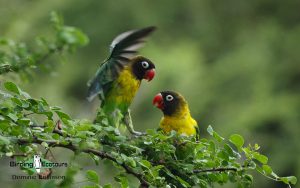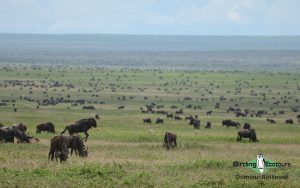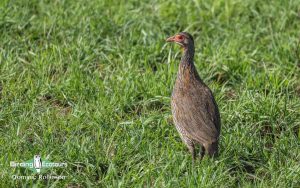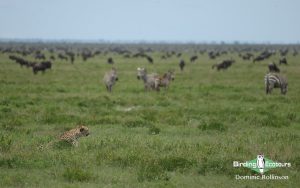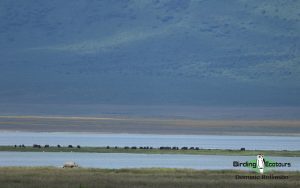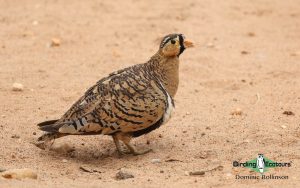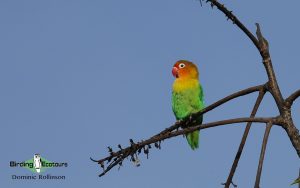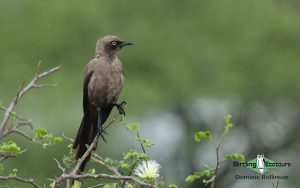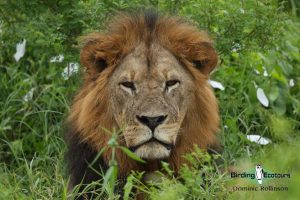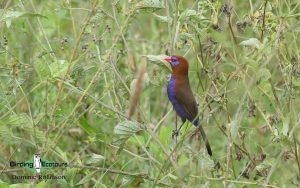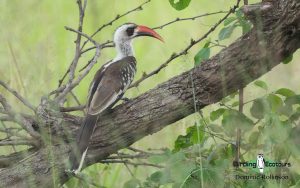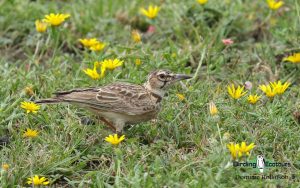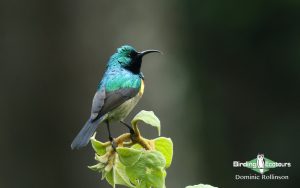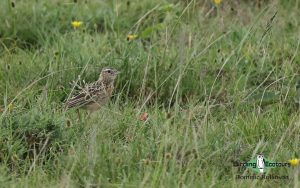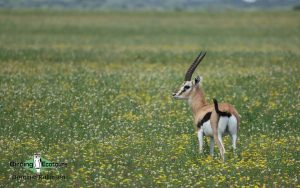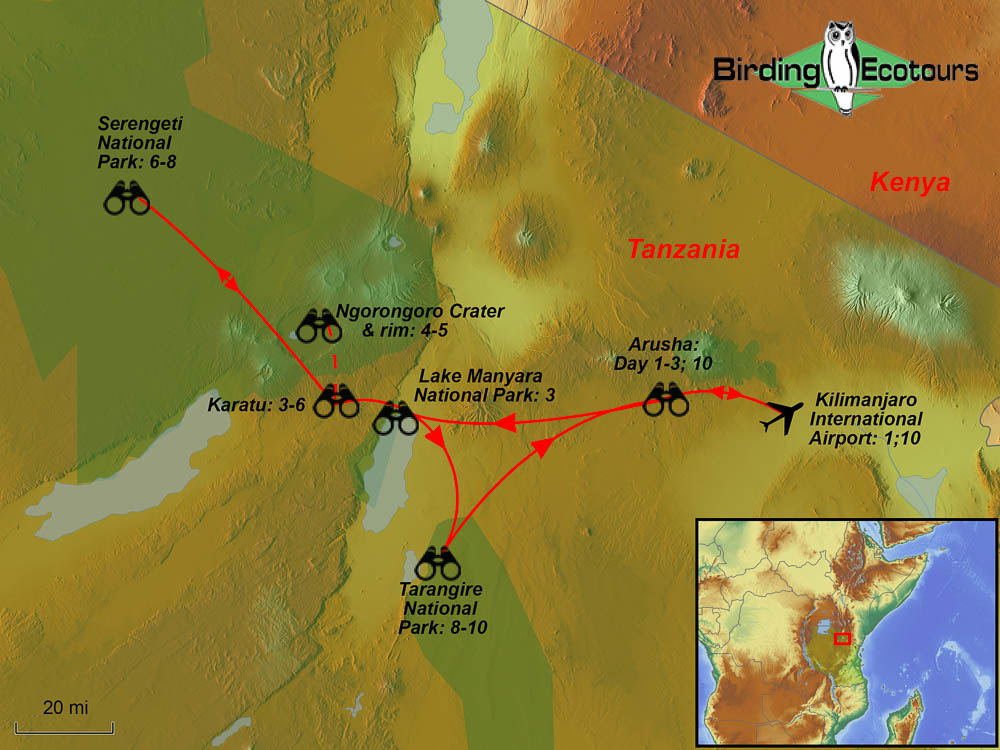Northern Tanzania Birding Tour - Introduction to Africa
Go to: Tanzania Birding Tours | Birding Tours in Africa | All our birding tours
Northern Tanzania Birding Tour – Introduction to Africa
April 2026
This northern Tanzania birding tour is designed to give you the opportunity to experience the real Africa, given just 10 days. Where else can you see Leopard, Cheetah, Lion, and a hundred spectacular bird species in a single day? Where else can you see Africa’s highest mountain (Kilimanjaro) and two of the world’s most famous game parks (the Serengeti and the spectacular Ngorongoro Crater)? This northern Tanzania birding tour not only offers an impressive diversity of localized bird species but also incredible wildlife sightings, most importantly the mind-blowing wildebeest migration through the Serengeti, which simply must be seen to be believed!
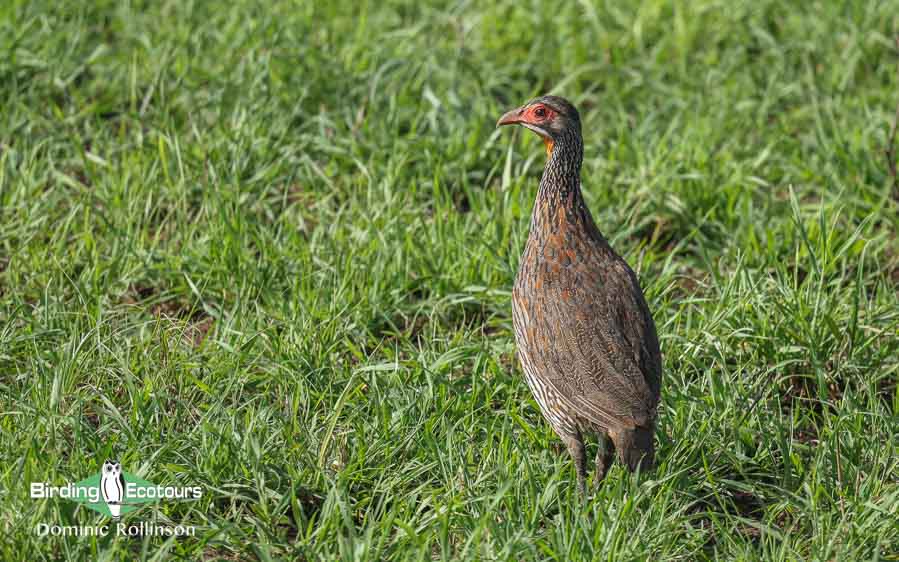
We begin this tour at Kilimanjaro International Airport near Arusha. Flying into this airport, weather-permitting, you might get views of Africa’s highest mountain. From here we visit the Lark Plains, north of Arusha, for some highly localized species, including Beesley’s Lark and Athi Short-toed Lark. We then visit the famed Ngorongoro Crater (enjoying Lake Manyara National Park en route) which is a unique and awe-inspiring experience. Before leaving the Ngorongoro Conservation Area we will spend an enjoyable day birding the forests on the crater rim, where we will target several range-restricted species such as Brown Woodland Warbler, African Hill Babbler and Mbulu White-eye.
Next, we head to the spectacular Serengeti National Park which not only has high densities of big mammals such as Lion, African Elephant, and the spectacular wildebeest migration, but also several highly sought-after birds that we’ll be on the lookout for. These include some very range-restricted species such as Maasai Apalis, Fischer’s Lovebird, Rufous-tailed Weaver, Red-throated Tit, Grey-crested Helmetshrike, and a range of others, along with many widespread African birds.
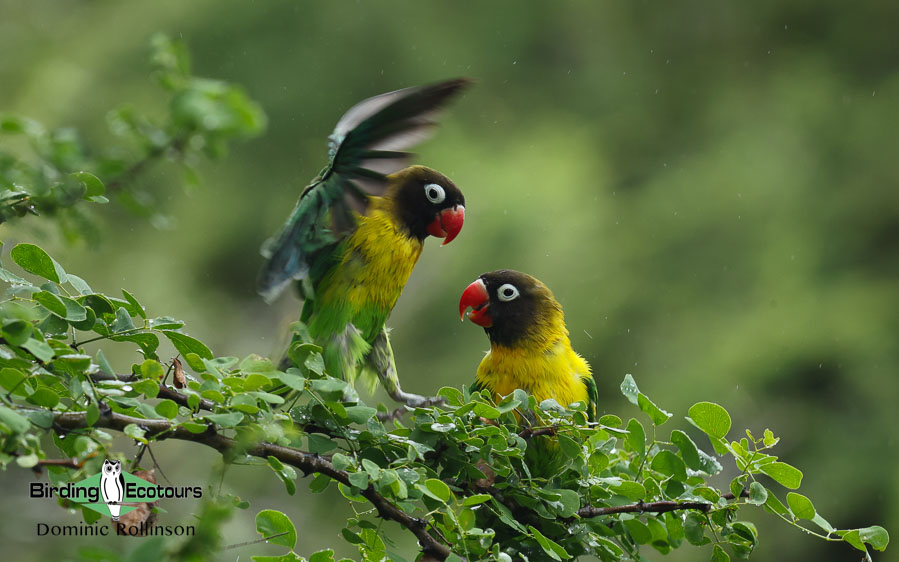
Finally, we spend two nights in Tarangire National Park, where we look for Northern Pied Babbler, Yellow-collared Lovebird, Pangani Longclaw, Ashy Starling, and other range-restricted birds among a very high concentration of African Elephants and baobab trees. Northern Tanzania has an impressive number of range-restricted bird species, and we hope to find many of them on this exciting birding and wildlife safari.
For this trip we can also arrange private departures. We recommend combining it with
1) a tour of the Eastern Arc Mountains, which boast many Tanzanian mountain forest endemics, and
2) a short extension to Pemba Island. Pemba Island is wilder than Zanzibar and has some endemic birds.
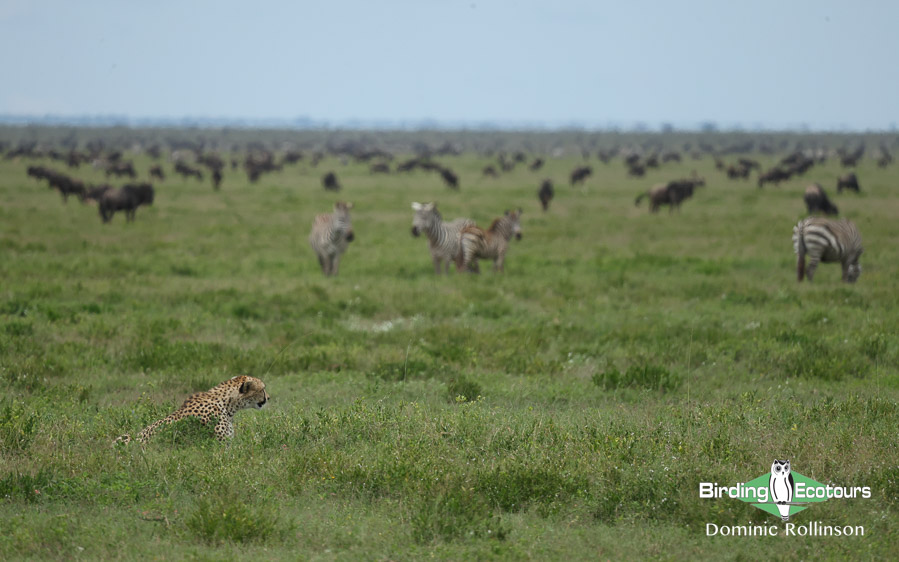
Itinerary (10 days/9 nights)
Day 1. Arrival in Arusha
Today is your arrival day into Arusha’s Kilimanjaro International Airport and you can arrive at any time, as we don’t have any planned birding on this day. Leisurely birding around the lodge grounds may, however, produce African Black Duck, Silvery-cheeked Hornbill, White-eared and Brown-breasted Barbets, Black-throated Wattle-eye, Grey-Olive Greenbul, Kenrick’s Starling, Rüppell’s Robin-Chat, Mountain Wagtail and the localized Taveta Weaver.
Overnight: Ngare Sero Mountain Lodge, or similar, Arusha
Day 2. Birding the Lark Plains
Our first full day of birding on this tour is certainly an exciting one as we make an early start, heading north out of Arusha (with Mount Meru as a backdrop) for a full day of fantastic plains and dry-country birding. Weather-permitting we will enjoy distant views of Africa’s highest mountain, Mount Kilimanjaro, rising out of the vast African plain.
We will spend time birding the (aptly named) Lark Plains for the rare and localized Beesley’s Lark (less than 200 remaining) along with a host of other lark species, including Fawn-colored, Short-tailed, Athi Short-toed, and Rufous-naped Larks and Fischer’s Sparrow-Lark. Other species for which we keep an eye out for on the plains include Kori Bustard, Eastern Chanting Goshawk, Greater Kestrel, Temminck’s and Double-banded Coursers, Yellow-throated and Chestnut-bellied Sandgrouse, Abyssinian and Capped Wheatears, Taita Fiscal, and numerous others.
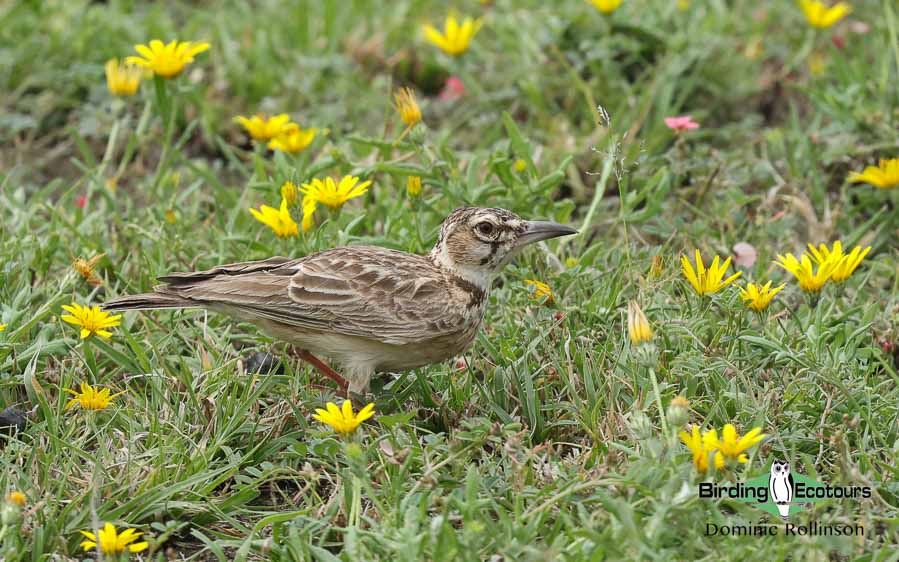
Many Serengeti-type birds can also be found here in the grassland and dry woodland habitat. Red-throated Tit is possible, as are some fine barbet species. We also hope to see our first mousebirds in the form of Speckled and Blue-naped Mousebirds (with White-headed Mousebird occasionally seen). The colonially nesting Grey-capped Social Weaver is always a delight, and we may see (and hear the loud call of) Nubian Woodpecker. Other species to look out for in the woodlands include Mouse-colored Penduline Tit, Red-fronted Prinia, Grey Wren-Warbler, Rosy-patched Bushshrike, Spotted Palm Thrush, Beautiful Sunbird, Pale White-eye, Kenya Sparrow, Black-faced Waxbill and Southern Grosbeak-Canary. After birding the area for most of the day, we eventually head back to Arusha for the night.
Overnight: Ngare Sero Mountain Lodge, or similar, Arusha
Day 3. Lake Manyara birding and transfer to Karatu
After breakfast we will make our way out of Arusha and arrive at Lake Manyara National Park in the late morning. Here we usually add quite a number of birds to our list and will enjoy a picnic lunch while being distracted by many exciting bird species. In the forested areas we’ll be on the lookout for Narina Trogon, Grey Cuckooshrike, Mountain Wagtail, Crowned Hornbill, and the huge Silvery-cheeked Hornbill, among others. In the more open woodland, we should hopefully find Spotted Palm Thrush, Red-and-yellow Barbet, White-bellied Tit, Banded Parisoma, Rufous Chatterer, Rufous-tailed Weaver, Steel-blue and Straw-tailed Whydahs, and Purple Grenadier. The reserve is particularly good for raptors and some of our targets today include Lappet-faced and White-backed Vultures, Bateleur, Crowned Eagle, African Hawk-Eagle, African Goshawk, Verreaux’s Eagle-Owl and the diminutive Pearl-spotted Owlet.
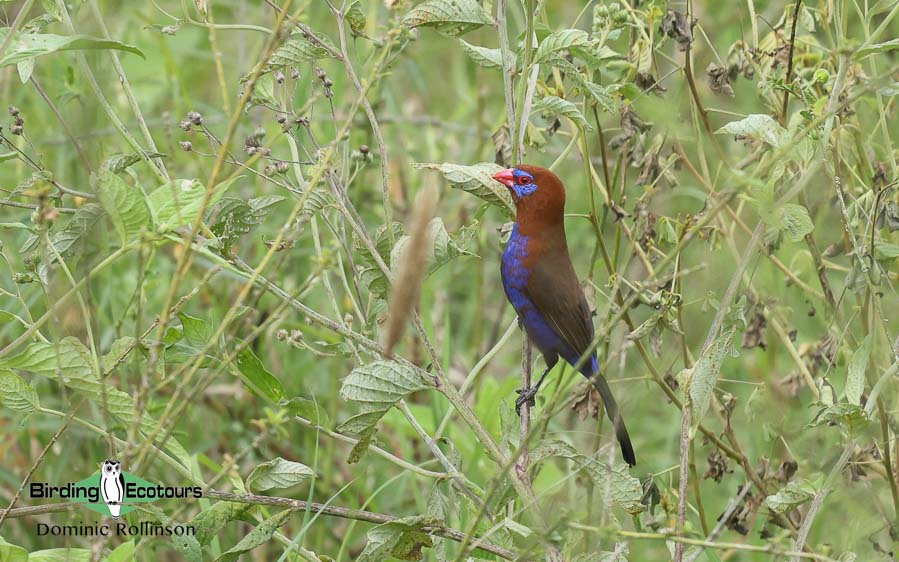
Depending on water levels, the shallow alkaline lake will be visited to enjoy the flocks of both Greater and Lesser Flamingos along with Great White Pelican, the massive Goliath Heron, and many other ducks, storks, and herons. After a few hours in the reserve, we will transfer to our lovely lodge on the outskirts of the nearby town of Karatu, which will be our base for the next three nights.
Overnight: Karatu
Day 4. The unforgettable Ngorongoro Crater
Today we have the full day to bird the Ngorongoro Crater and crater rim which will prove to be a sure trip highlight. Descending into the crater floor is truly an unforgettable experience. There’s a very high density of Lion and large herbivores, some of them seemingly trapped by the natural enclosure formed by this huge, nicely intact caldera. About 25,000 large mammals, which also include Black Rhinoceros and a pool with Hippopotamus, inhabit the crater floor. With luck we might also see some of the smaller predators, like Serval, Bat-eared Fox, and African Golden Wolf, which was formerly classified as an African variant of the Eurasian Golden Jackal but now is thought to be more closely related to the Grey Wolf. As always, however, our main focus is on birds, although we stop for the other wildlife too, and we expect many additions to our growing bird list – Lesser Flamingo, Grey Crowned Crane, Abdim’s Stork, Black-bellied and Kori Bustards, Pectoral-patch Cisticola, Rufous-tailed Weaver, Rosy-throated Longclaw, and many others are expected.
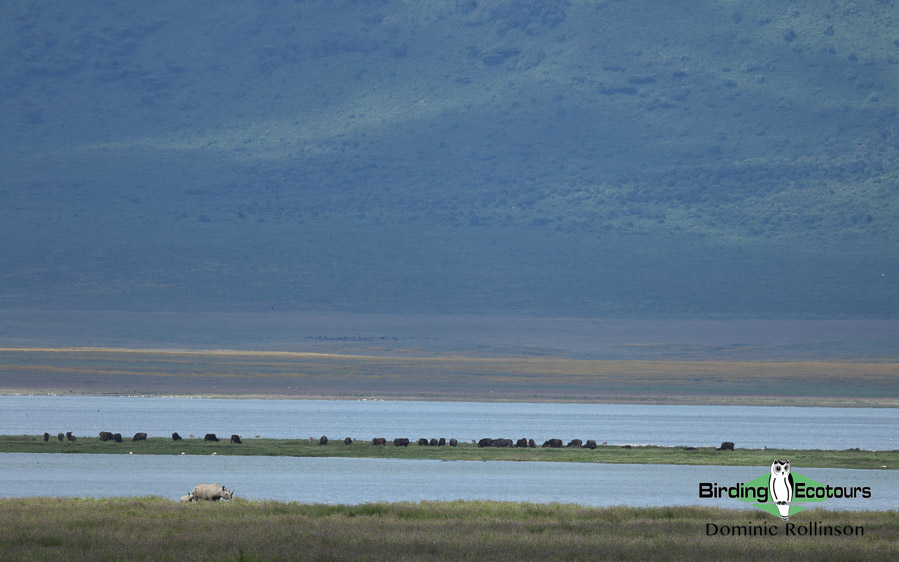
Large African animals, spectacular birds (of a staggering variety), and stunning scenery combine to make this one of the most incredible wildlife experiences on Earth; the rim of this crater rises an incredible 2,000 feet (600 meters) above the plain at the bottom (which has a diameter of 15 miles (24 kilometers)).
The forested sections of the crater rim will also be birded, looking for localized specials such as Golden-winged Sunbird, Brown-headed Apalis, and the curious Oriole Finch, which we may be lucky enough to encounter here too. Other species to look out for here include Eastern Bronze-naped Pigeon, Dusky Turtle Dove, Grey-capped Warbler, Eastern Double-collared Sunbird, White-eyed Slaty Flycatcher, Brown-backed Woodpecker, Mbulu White-eye, and Thick-billed Seedeater.
Overnight: Karatu
Day 5. Birding the lush forests of the Ngorongoro Crater rim
Today we will visit the Endoro section of Ngorongoro Conservation Area as well as the splendid Gibb’s Farm, which is a great place for lunch and to add new birds to the growing list. This morning’s birding will be quite different from the rest of the trip as we enjoy some fine forest birding while walking the Elephant Caves Trail. Highlights of this morning will hopefully include, Narina Trogon, Moustached Tinkerbird, Pallid and Scaly-throated Honeyguides, African Broadbill, Purple-throated Cuckooshrike, Black-fronted Bushshrike, Blue-mantled Crested Flycatcher, Brown-headed Apalis, Grey-capped Warbler, Black-headed Mountain Greenbul, Brown Woodland Warbler, African Hill Babbler, Mbulu White-eye, Grey-headed Nigrita and Red-throated Twinspot. We will keep an eye out overhead for the likes of Ayres’s Hawk-Eagle, Black Sparrowhawk, Augur Buzzard and Nyanza Swift. The prehistoric-looking Schalow’s Turaco adds a spectacular flash of crimson and green, and, if one gets a good view, its spectacular crest leaves even a hardened birder gob smacked.
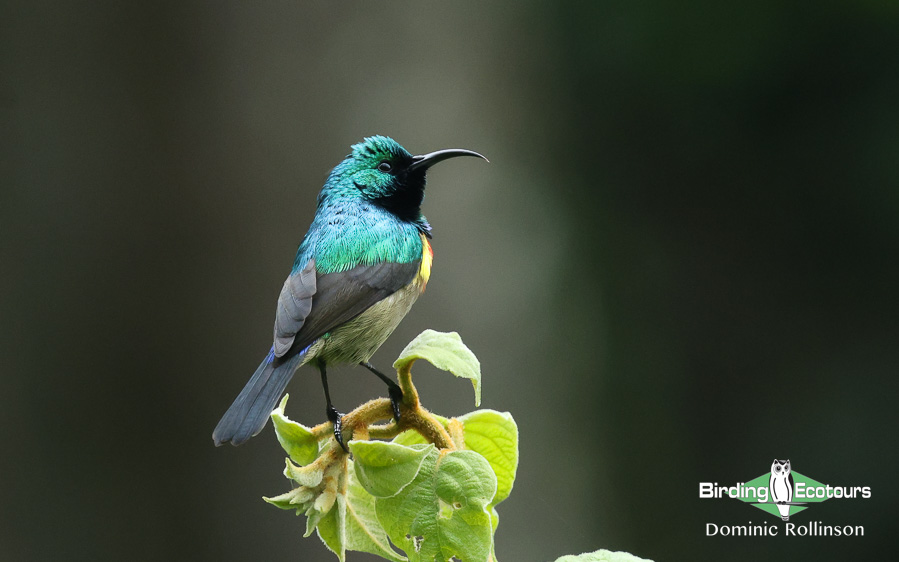
We will enjoy lunch in the wonderful, relaxed atmosphere of Gibb’s Farm which is normally full of birds. After lunch we will bird the large property where we hope to find Cinnamon-chested Bee-eater, Dusky Turtle Dove, White-tailed Blue Flycatcher, White-eyed Slaty Flycatcher, Green-headed Sunbird, Holub’s Golden Weaver, Black-and-white Mannikin, Southern Citril and Yellow-bellied Waxbill.
Overnight: Ngorongoro Crater rim lodge
Days 6-7. Serengeti: wildebeest, predators, and a dazzling array of spectacular birds
This morning we embark on a spectacular journey that few people will ever forget. If you’ve never been to Africa before, you’re likely to be amazed by African Elephant, African Buffalo, and the sheer number of bird species. After an exciting drive we’ll reach the Serengeti, where we enjoy the huge and impressive wildebeest migration, not to mention the large numbers of Plains Zebras and Thomson’s Gazelles. Other megafauna that we’ll search for include Topi, Common Eland, Grant’s Gazelle, Bohor Reedbuck, and Masai Giraffe. This is one of the best places on the planet to see big cats – we’ve sometimes seen Lion, Leopard, and Cheetah in a single day, as well as some of the smaller cats such as Serval and Caracal. Finding a kill should allow us to see a good number of vulture species, such as Rüppell’s, White-backed, Lappet-faced, White-headed, and Hooded Vultures.
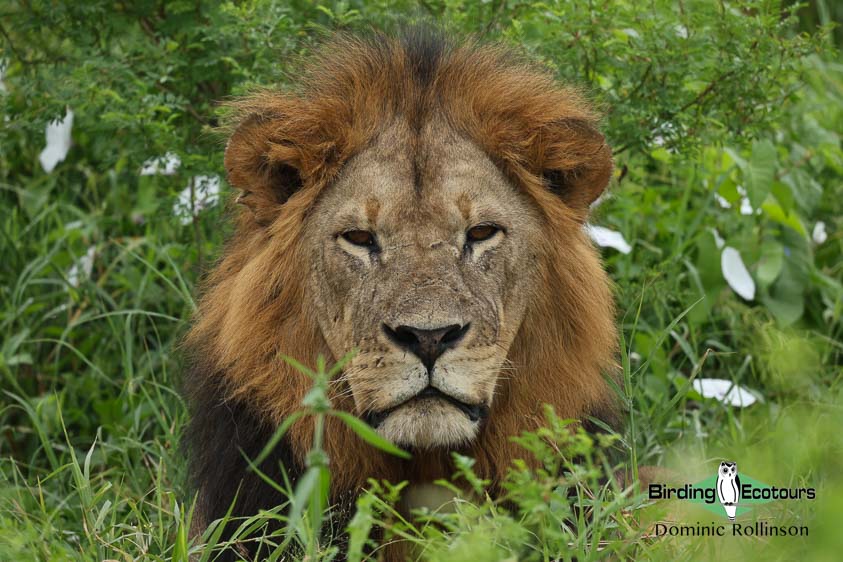
Birds of prey are common here, including the most colorful of the world’s eagles, Bateleur. Secretarybird regally roams the plains searching for its serpentine prey, while Common Ostrich tries to be regal but without much success. Smaller birds are everywhere, and so many of them are brightly colored – such as Little Bee-eater, Purple Grenadier, Lilac-breasted Roller, Hildebrandt’s Starling, Beautiful Sunbird, and many others. Other target species that we will look for in the plains and open savanna of the Serengeti include White-bellied Bustard, Coqui Francolin, Temminck’s Courser, Dark Chanting Goshawk, Pygmy Falcon and Pangani Longclaw.
Interestingly, the Serengeti is home to quite a few extremely localized bird species. One of these is Maasai Apalis, which favors the weird whistling-thorn habitat that we’ll visit for this species; it only occurs here and over the border into Kenya. Red-throated Tit, Fischer’s Lovebird, and Grey-crested Helmetshrike are other range-restricted species we will look for in the Serengeti. Other important target birds here include Rufous-tailed Weaver and the Tanzanian endemics, Tanzanian Red-billed Hornbill and Grey-breasted Spurfowl. The huge Kori Bustard can be seen roaming the grasslands throughout the Serengeti plains.
Overnight: Serengeti
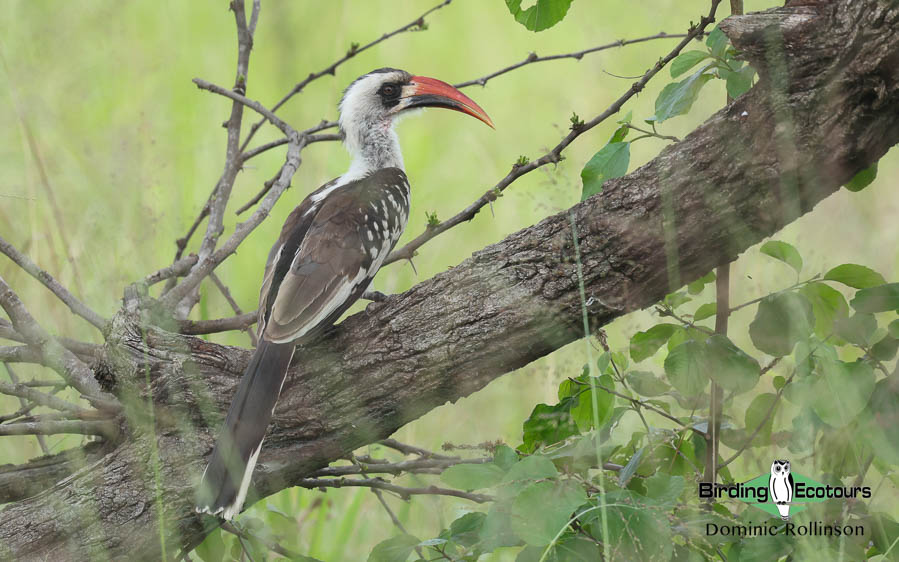
Day 8. Transfer to Tarangire National Park
After breakfast, we make the drive back through the animal-filled plains of the Serengeti where we will again hopefully enjoy further looks at massive herds of migrating wildebeest, zebra and gazelle. We may also have time to look for any remaining bird targets before we finally leave this wildlife haven.
After a long day on the road, we will make it to Tarangire National Park, a breathtaking place of red (because of the soil) elephants, baobabs, savanna-clad hills, and wild rivers: the real Africa as far as scenery goes. Here at magnificent Tarangire National Park we have some localized northern Tanzania specials and endemics to target: Yellow-collared Lovebird, the long-tailed Ashy Starling, and the charismatic Northern Pied Babbler, which we usually manage to find. In Acacia woodlands around the park, we should encounter Von der Decken’s and Northern Red-billed Hornbills, Yellow-necked and Red-necked Spurfowl, Black-faced Sandgrouse, Bearded Woodpecker, Abyssinian Scimitarbill, Eastern Violet-backed Sunbird and many others. We may also come across larger terrestrial birds like Secretarybird, White-bellied, Hartlaub’s and Buff-crested Bustards, and the massive Southern Ground Hornbill, while Common Ostrich puts them all to shame, as far as size goes. If sufficient rains have arrived in the area, Tarangire can be a good place to look for Black Coucal and Dwarf Bittern. The massive baobabs dotted throughout the landscape host good numbers of Mottled Spinetail which use the hollows within old trees to build their nests.
The Tarangire River (after which the park is named) attracts good numbers of waterbirds including the likes of White-faced Whistling Duck, Knob-billed Duck, Saddle-billed Stork, Hamerkop and Grey Crowned Crane which may be seen as we traverse this wonderful park.
Overnight: Tarangire National Park
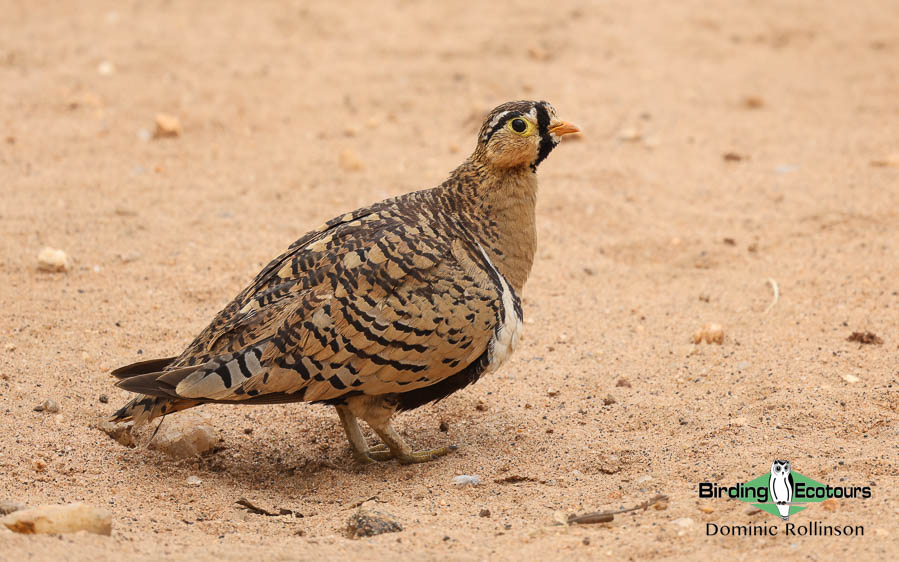
Day 9. Full day in Tarangire National Park
This will be our final full day of our Tanzanian birding safari and we will spend the day looking for any remaining target species (as described under Day 8) as well as enjoying the fine wildlife-viewing that is possible in Tarangire. We will likely end the afternoon enjoying a sundowner drink on the lodge’s balcony which overlooks the Tarangire River, while being harassed by cheeky Ashy Starlings, with African Scops Owls giving their soft purr-like call as the sun sets.
Tarangire offers night drives to enjoy some of the area’s nocturnal birds and wildlife and, although these drives are not included in the tour price, it is possible to join one of these exciting drives. Some of the nocturnal species which may be seen at night include Verreaux’s Eagle-Owl, Southern White-faced Owl, Bronze-winged and Three-banded Coursers, East African Springhare, Northern Lesser Galago and African Savanna Hare.
Overnight: Tarangire National Park
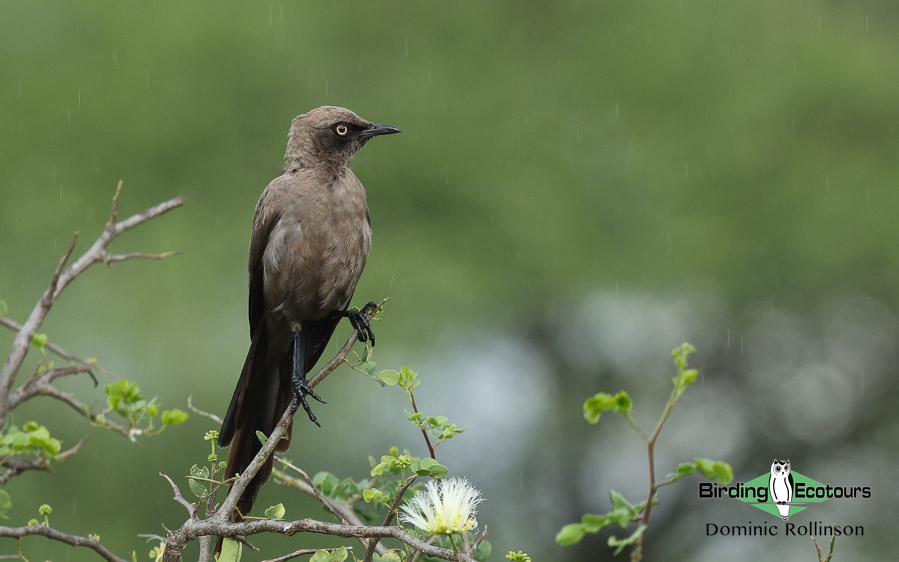
Day 10. Departure from Arusha
Unfortunately, today marks the end of an incredible ten days in northern Tanzania. After breakfast we will make our way to Kilimanjaro International Airport, just outside of Arusha, from where our flights will depart. It is a roughly four-hour drive to Arusha, so please do not book flights any earlier than 3pm.
Overnight: not included
Please note that the itinerary cannot be guaranteed as it is only a rough guide and can be changed (usually slightly) due to factors such as availability of accommodation, updated information on the state of accommodation, roads, or birding sites, the discretion of the guides and other factors. In addition, we sometimes have to use a different guide from the one advertised due to tour scheduling or other factors.
Download ItineraryTanzania: Introduction to Africa Set Departure Birding Trip Report
30 APRIL – 07 MAY 2024
By Dominic Rollinson
DOWNLOAD TRIP REPORT

Yellow-collared Lovebird is a Tanzanian endemic that we saw wonderfully well on this tour.
Overview
Tanzania offers some of East Africa’s top birding and wildlife experiences, which makes it one of Africa’s most popular wildlife tourism destinations. With a bird list of over 1,000 species and nearly 40 endemics, Tanzania should be high on the agenda for most birders. Most of the endemics are found in the Eastern Arc Mountains in the interior of the country, which are generally difficult to access. Our 8-day ‘Introduction to Africa’ tour visited Tanzania’s more popular northern savanna circuit which is well-geared for tourism with high-quality lodges and good infrastructure.
This northern Tanzania birding tour was not only focused on birds, as we spent time searching for and enjoying a wide array of other animals, with the tour being specifically timed to coincide with the annual wildebeest migration through the Serengeti. The wildebeest migration lived up to expectations and we enjoyed massive numbers of Blue Wildebeest (as well as smaller numbers of Plains Zebra and Thomson’s Gazelle) in the Serengeti. Associated with these large herbivore herds were impressive numbers of predators, most notably Lions as well as a single Cheetah. We also had some memorable encounters with larger mammals with many African Elephants seen and a couple sightings of Black Rhino in the famous and spectacular Ngorongoro Crater.
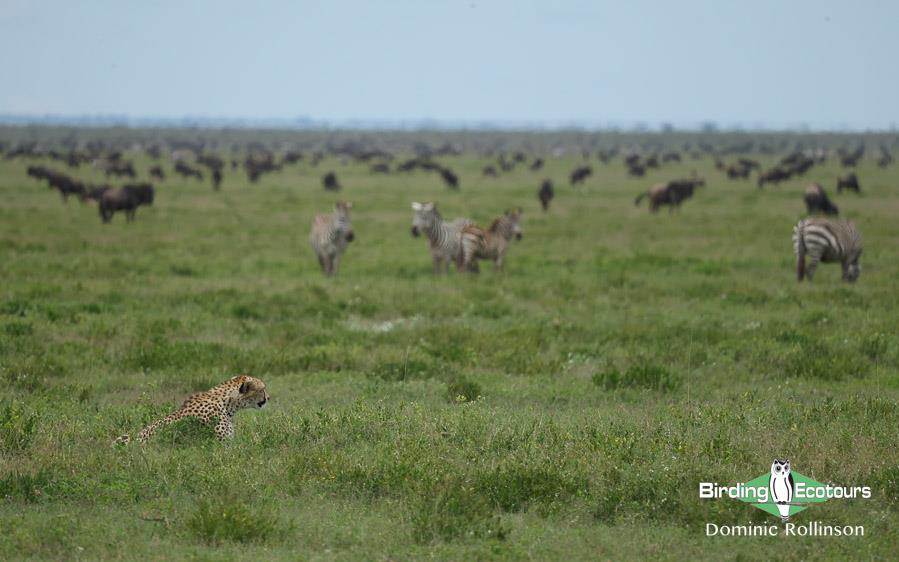
We had some incredible mammal sightings on this trip. Here, a Cheetah watches over the massive herds of migrating Blue Wildebeest and Plains Zebras.
The birding highlights were many and we started with a bang in the Lark Plains, north of Arusha, where we connected with the Critically Endangered Beesley’s Lark and other dry-country and grassland specials such as Short-tailed and Athi Short-toed Larks, Red-throated Tit, White-headed Mousebird, Pygmy Batis and Southern Grosbeak-Canary. We then made a long transfer west (passing along the rim of the Ngorongoro Crater) into the Serengeti, which gave us a whole different assortment of bird species, such as Grey-breasted Spurfowl, Fischer’s Lovebird, Tanzanian Red-billed Hornbill, Karamoja Apalis and Purple Grenadier.
We then retraced our steps and spent an afternoon in the Ngorongoro Crater itself which was just full of birds (including masses of waterbirds) and other wildlife. Some of the birding highlights here included Rosy-throated Longclaw, Golden-winged Sunbird, Rufous-tailed Weaver and the massive Kori Bustard.
A couple of nights in the Karatu area meant we had time to explore Lake Manyara National Park for the day with a good selection of savanna species on offer here. We then also birded the forests on the Ngorongoro Crater rim, along the Elephant Cave Trail, with highlights including African Broadbill, Narina Trogon, Schalow’s Turaco, Pallid Honeyguide, Purple-throated Cuckooshrike and the localized Mbulu White-eye.
The tour ended with a fantastic couple days in Tarangire National Park’s baobab woodlands, which added Yellow-collared Lovebird, Ashy Starling, Bronze-winged and Three-banded Coursers, Black-faced Sandgrouse and noisy Yellow-necked Spurfowl. We enjoyed our final encounters with Lion and African Elephant before making our way back to Arusha where we said our goodbyes.
All in all, we recorded 365 species of birds and 38 species of mammals. A detailed daily account can be read below, and the full bird and mammal lists are located at the end of the report.
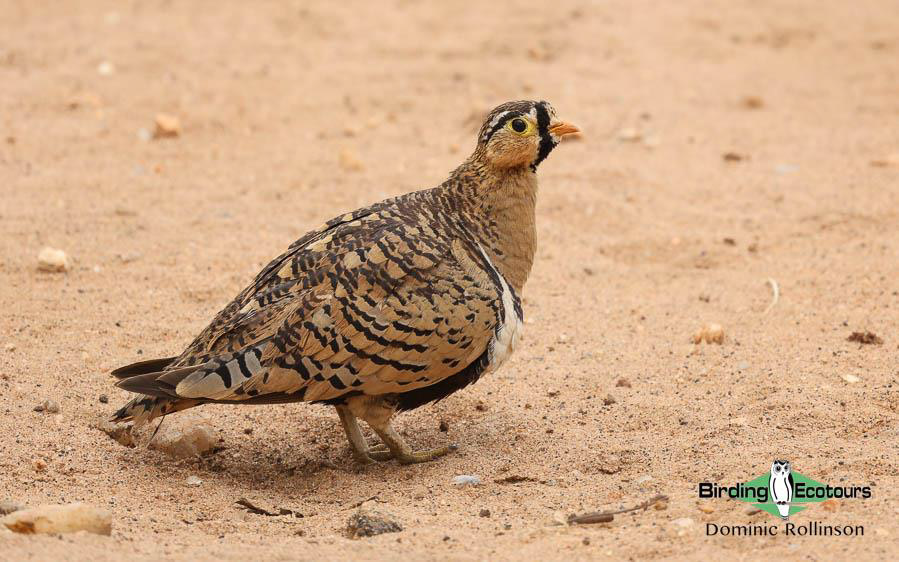
The striking Black-faced Sandgrouse was fairly numerous in Tarangire National Park.
Detailed Report
Day 0, 29th April 2024. Lake Duluti birding
As we had all arrived a day early, Chris, Pam and I decided to take a walk around Lake Duluti which is a volcanic crater lake on the edge of Arusha town. Lake Dululti offered good chances at a few species that we were unlikely to encounter elsewhere on the tour and so we enjoyed walking the full loop around the lake, with a leisurely lunch taken on the shores of the lake. Highlights from our few hours here included Silvery-cheeked Hornbill, White-eared Barbet, Mountain, Little and Grey-olive Greenbuls, Black-throated Wattle-eye, the range-restricted Taveta Weaver and good looks at a pair of African Fish Eagles.
The rest of the afternoon was spent relaxing around the lodge, excitedly contemplating our week on safari in northern Tanzania while enjoying common Arusha birds such as Superb Starling, Variable Sunbird, Red-cheeked Cordon-bleu and Southern Citril.
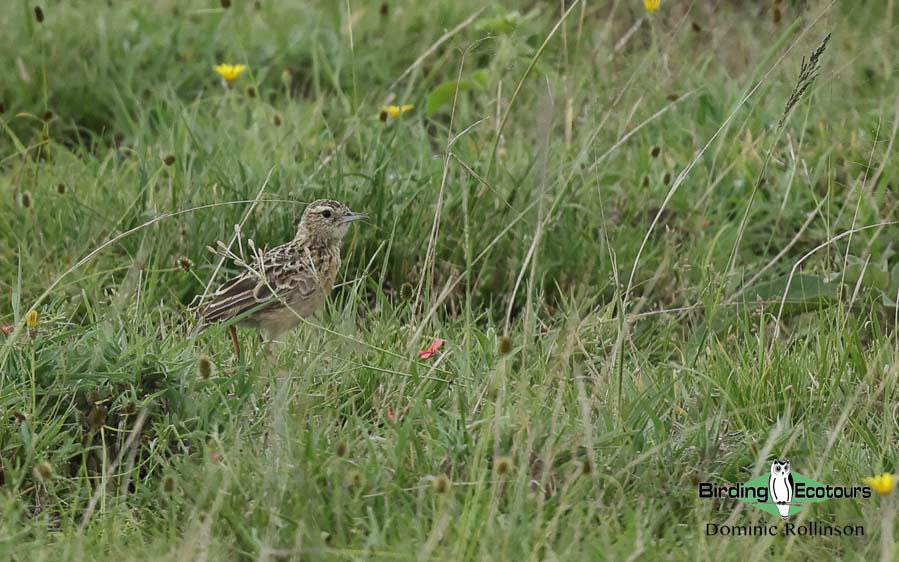
The Critically Endangered Beesley’s Lark.
Day 1, 30th April 2024. Engikaret Plains (Lark plains) and Oldonyo Sambu birding
For our first official day of the tour, we met our local guide and driver, Godbless, at our accommodation and left Arusha early, heading north towards the Kenya border to Engikaret Plains (known by birders as Lark Plains), where our primary target would be the Critically Endangered Beesley’s Lark. The Engikaret Plains represents the only reliable site to observe this extremely rare lark, whose population is thought to be less than 100 individuals. The current thinking is that Beesley’s Lark may be re-lumped with Spike-heeled Lark after a reconsideration of features originally used to split the species. Whether the species remains split or lumped, it’s still an interesting bird to see and I hope that they long remain in their plains haven.
It didn’t take long after meeting our local Maasai guide until we found a single Beesley’s Lark, which eventually showed well, after a bit of a game of hide-and-seek. Other interesting birds that we saw out on the plains included Chestnut-bellied Sandgrouse, Taita and Northern Fiscals, Fischer’s Sparrow-Lark, Foxy, Short-tailed, Red-capped and Somali Short-toed Larks, Ashy Cisticola, Capped Wheatear and Crowned Lapwing. We then birded the nearby scrub which held many exciting species, including Eastern Chanting Goshawk, Blue-naped Mousebird, Red-and-yellow Barbet, Yellow-bellied Eremomela, Spotted Palm (Mourning) Thrush, Beautiful Sunbird, Kenya and Chestnut Sparrows, Reichenow’s Seedeater, White-bellied Canary and Southern Grosbeak-Canary.
We then moved to an incredibly productive area of dense trees in a dry riverbed (enjoying views of the Kilimanjaro and its vanishing glacier in the distance en route), where we enjoyed a bird-interrupted picnic lunch. Some of the special birds we came across included Namaqua Dove, White-bellied Go-away-bird, Lappet-faced Vulture, White-headed Mousebird, Abyssinian Scimitarbill, Little Bee-eater, Bearded Woodpecker, Pygmy Batis, Slate-colored Boubou, Rosy-patched and Grey-headed Bushshrikes, Red-throated Tit, Grey Wren-Warbler, Red-fronted Prinia, Banded Parisoma, Bare-eyed Thrush, Yellow-spotted Bush Sparrow and Black-faced Waxbill.
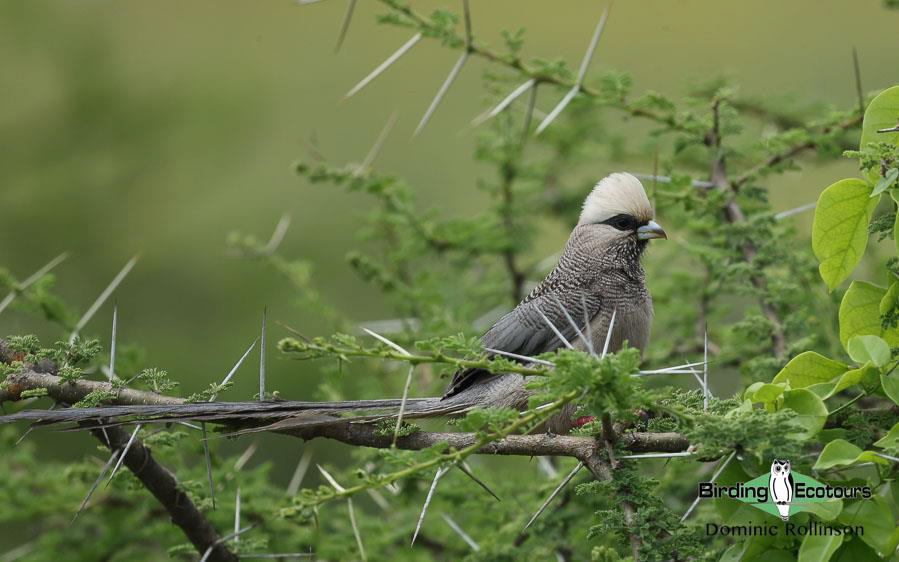
The scarce White-headed Mousebird was seen near the Engikaret Plains.
In the general area, we also enjoyed our first looks at large mammals such as Plains Zebra, Thomson’s Gazelle, Blue Wildebeest and Masai Giraffe.
For our final birding of the day, we birded the Oldonyo Sambu area which again proved really productive as we further added Augur Buzzard, Red-fronted Tinkerbird, Red-fronted Barbet, Chinspot Batis, Brubru, Brown-crowned Tchagra, Long-tailed Fiscal, Red-faced Crombec, Red-rumped Swallow, Hildebrandt’s Starling, Abyssinian Wheatear, Village Indigobird and Streaky Seedeater. After a successful day out, we decided to head back a bit earlier and enjoy some time off in Arusha in the late afternoon.
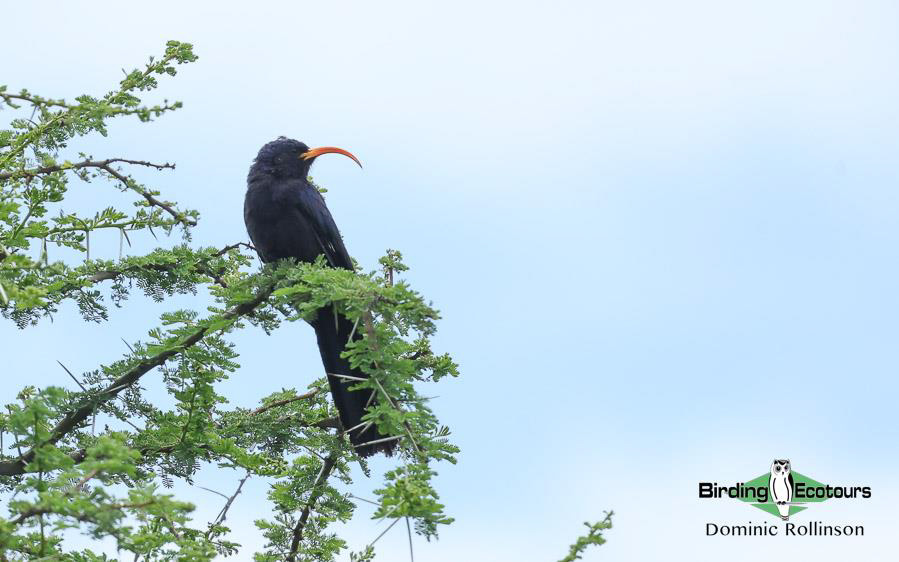
We had great looks at Abyssinian Scimitarbill near Engikaret.
Day 2, 1st May 2024. Transfer from Arusha to the Serengeti, Ngorongoro Crater en route
Today’s drive was a very long one as we made our way from Arusha west to the Serengeti. The drive wouldn’t have taken too long but there is just so much to see and take in en route, which meant we spent most of the day traveling. Along the drive we experienced our first looks at the Ngorongoro Crater as well as the mind-blowing wildebeest migration.
One of our early stops was on the escarpment overlooking Lake Manyara, where we had good looks at a few Nyanza Swifts as well as Little Swifts. A fairly quick stop at the Ngorongoro Crater viewpoint provided us with sensational views over the crater, where we scoped Common Ostrich, Black Rhino and African Buffalo, with Cinnamon-chested Bee-eater, White-eyed Slaty Flycatcher, Red-faced Cisticola and Thick-billed Seedeater seen a little closer by.
At our lunch stop, we were again distracted with Mountain Buzzard, Hunter’s Cisticola, African Stonechat, Eastern Double-collared Sunbird and had very brief views of the gorgeous Golden-winged Sunbird. Eventually we managed to focus on eating lunch before continuing our journey westwards.
As we made our way down from the crater rim, we dropped into the plains and savanna which held a different assemblage of bird species and got our first looks at the impressive wildebeest migration. The numbers of Blue Wildebeest (with smaller numbers of Plains Zebra and Thomson’s and Grant’s Gazelles) is difficult to comprehend, with dark figures dotting the landscape as far as the eye can see. As we slowly made our way through the vast herds, we of course saw many interesting birds along the way too. Highlights in the plains included Silverbird, Yellow-billed Oxpecker, Greater Kestrel, Kori and Black-bellied Bustards, Rüppell’s Starling, Northern White-crowned Shrike, D’Arnaud’s Barbet and Double-banded Courser.
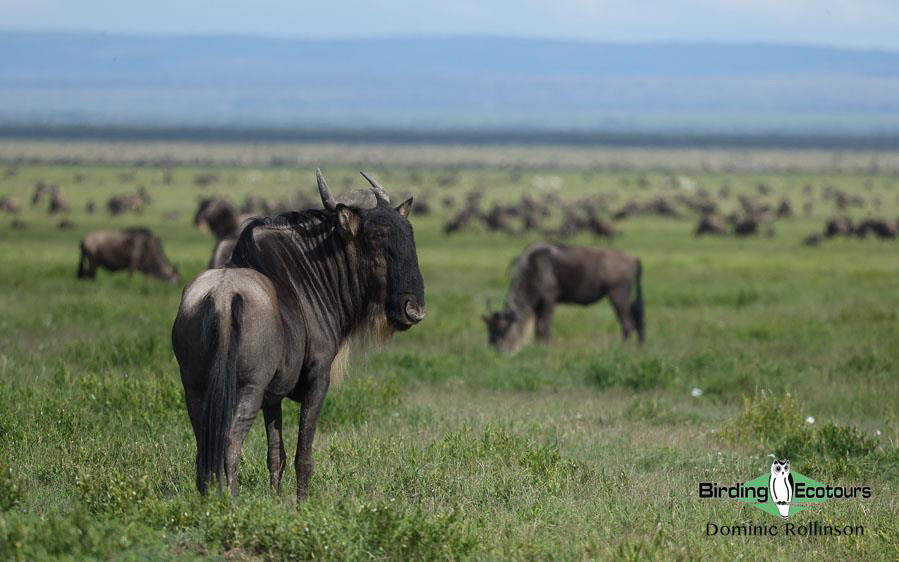
We crossed through massive herds of migrating Blue Wildebeest while in the Serengeti.
Entering the Serengeti National Park in the midafternoon, we soon encountered our first Lions with a good-sized pride of around 15 animals and had nice sightings of Hippo, Common Eland, Olive Baboon, Spotted Hyena, Impala, Tsessebe and the tiny Kirk’s Dik-dik. We then slowly made our way through the final stretch of savanna to make it to our lovely, tented camp which again took longer than anticipated as the birding and wildlife viewing was just so good! Bird highlights along this stretch included Grey-breasted Spurfowl (a Tanzanian endemic), Coqui Francolin, White-bellied Bustard, Temminck’s Courser, Secretarybird, Verreaux’s Eagle-Owl, Pygmy Falcon, Meyer’s Parrot, Grey-backed Fiscal, Magpie Shrike, Flappet Lark, Grey-headed Social Weaver, Steel-blue Whydah and many Yellow-throated Longclaw. After a tiring but exhilarating day, we finally made it to our accommodation, where we enjoyed a sundowner drink and a lovely evening meal.

Grey-breasted Spurfowl, a Tanzanian endemic.
Day 3, 2nd May 2024. A full day in Serengeti National Park
We had the full day in Serengeti National Park at our disposal today, and after our breakfast, we went out for a game drive, which of course proved incredibly productive. Along our camp’s entrance road, we saw many great birds including Coqui Francolin, Grey-breasted Spurfowl, Black-faced Sandgrouse, Double-banded and Temminck’s Coursers, Secretarybird, White-headed, Lappet-faced and White-backed Vultures, Dark Chanting and Gabar Goshawks, Nubian Woodpecker, Grey Kestrel, Rufous Chatterer, Silverbird, Quailfinch, Purple Grenadier, Kenya and Swahili Sparrows and Pangani Longclaw. Of course, we were never too far from large mammals and again found the likes of African Elephant, Lion (two females up in a tree), slender, Common Dwarf and Banded Mongooses, Black-backed Jackal, Common Warthog, Tsessebe, Plains Zebra and Masai Giraffe.
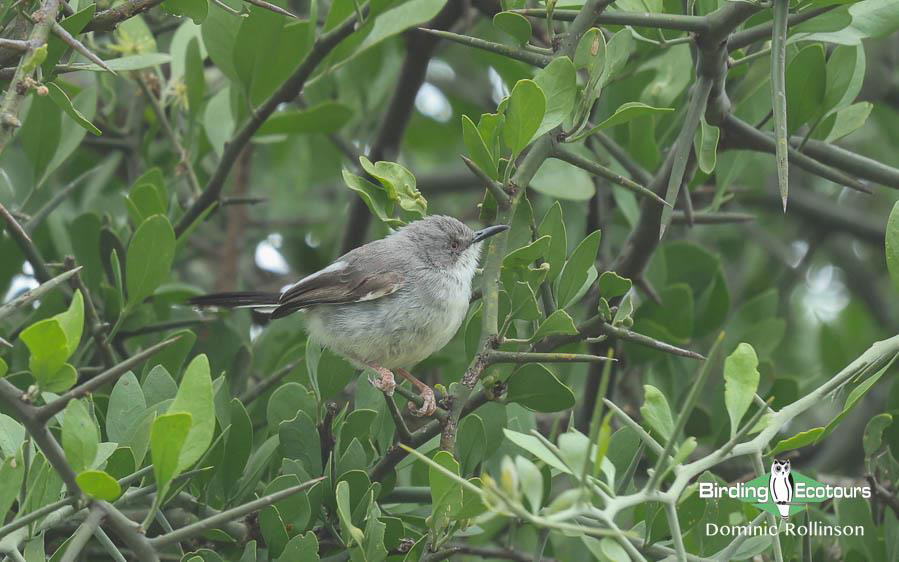
Karamoja Apalis has a tiny distribution within East Africa. The birds occurring in Tanzania and Kenya will soon be split as a separate species to those occurring in Uganda.
We then took a drive to some nearby woodland, which added the hoped-for Tanzanian Red-billed Hornbill, however, Grey-crested Helmetshrikes were nowhere to be seen. We made a stop in a large patch of whistling thorns, but Karamoja Apalis would have to wait until later. After an enjoyable morning, we headed back to camp for lunch and some downtime in the early afternoon.
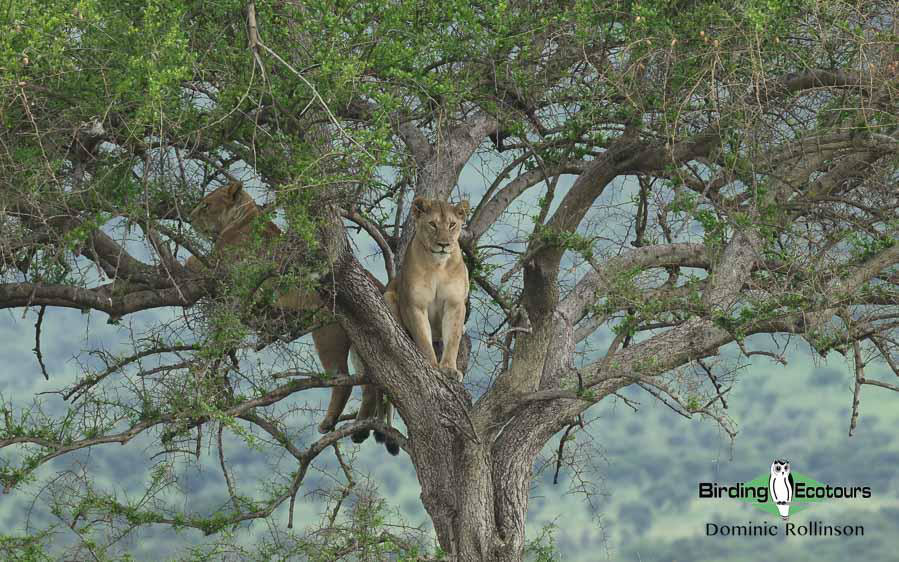
Tree-climbing Lions were seen in the Serengeti.
That afternoon, we again birded the area surrounding our camp and made our way a little further along the western corridor. A stop in the same patch of whistling thorn as this morning finally produced Karamoja Apalis while other exciting birds included Eastern Plantain-eater, Black Coucal (heard only), Red-fronted Barbet, Grey-headed Bushshrike, White-bellied and Red-throated Tits, Flappet Lark, Winding Cisticola, Red-billed and White-headed Buffalo Weavers, Speckle-fronted Weaver, Steel-blue Whydah and Golden-breasted Bunting.
Day 4, 3rd May 2024. Serengeti to Karatu with Ngorongoro Crater en route
Today, we left camp early as we had an epic day ahead of us as we made our way from the mighty Serengeti Plains to the awe-inspiring Ngorongoro Crater, and everything in between. Godbless did well to negotiate a particularly muddy patch of road and then we were on our way. We had another look for Grey-crested Helmetshrike, which unfortunately once again eluded us, but we enjoyed good long looks at a gentle herd of African Elephants as they quietly went about their business. At the other end of the size spectrum, we saw a couple tiny Grey Penduline Tits, which alerted us to their presence by their high-pitched calls.
We once again made our way back through the massive herds of migrating Blue Wildebeest and enjoyed watching a single Cheetah as it gazed out over the herds, likely choosing its next meal. While moving through the plains we encountered new birds such as Gull-billed Tern, Marabou Stork, Great Spotted Cuckoo, Striated Heron, Rüppell’s Vulture and Speke’s Weaver.
We eventually made it to the Ngorongoro Crater rim where Godbless sorted out entrance fees while we added Singing and Lynes’s Cisticolas. We then made our way nearly 2,000 feet (600 meters) down the slopes of the crater, where the fantastic birding continued with Yellow Bishop, Rufous-tailed Weaver, African Firefinch and the best of the lot, the gorgeous Golden-winged Sunbird, which was much more obliging this time around.
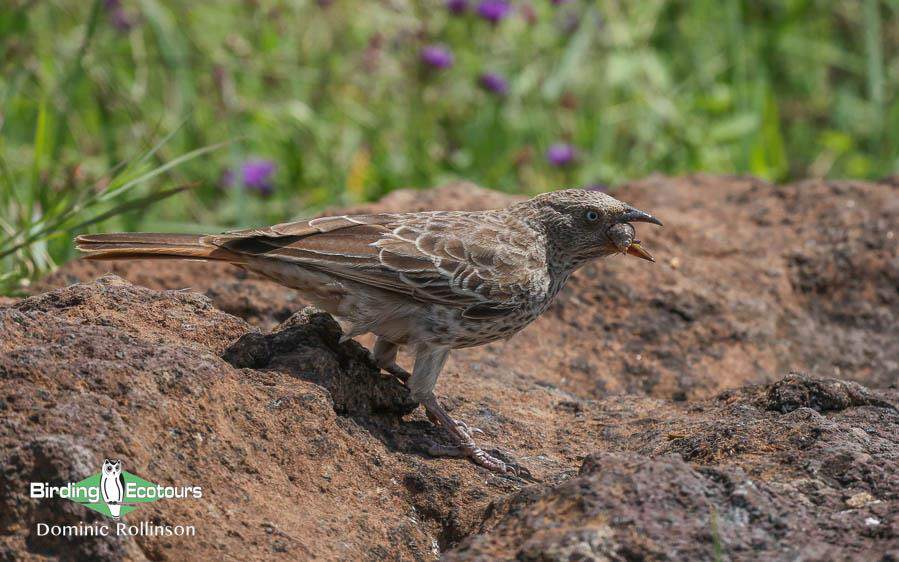
The endemic Rufous-tailed Weaver was seen well on the slopes of Ngorongoro Crater.
Lunch was taken in the shade of some tall figs where we watched groups of Rufous-tailed Weavers feeding, with coveys of comical Helmeted Guineafowl seen here too. After lunch, we took a drive through the plains alongside Lake Magadi, where we marvelled at the large numbers of Greater and Lesser Flamingos alongside smaller numbers of Yellow-billed Stork, Cape Teal, Red-knobbed Coot, Black-winged Stilt, Pied Avocet, Greater Painted-snipe, Grey-headed Gull, African Openbill, African Spoonbill and Black-necked Grebe.
Birding the grassy plains was equally productive, where we encountered the likes of Common Ostrich, Kori Bustard, Grey Crowned Crane, Secretarybird, Rufous-naped Lark, Fischer’s Sparrow-Lark, Banded Martin, White-winged and Fan-tailed Widowbirds, Pectoral-patch and Winding Cisticolas and Rosy-throated Longclaw. Mammal highlights in the plains included Lion, Spotted Hyena, Black-backed Jackal, Hippopotamus, Hartebeest and a distant mother and calf Black Rhino.
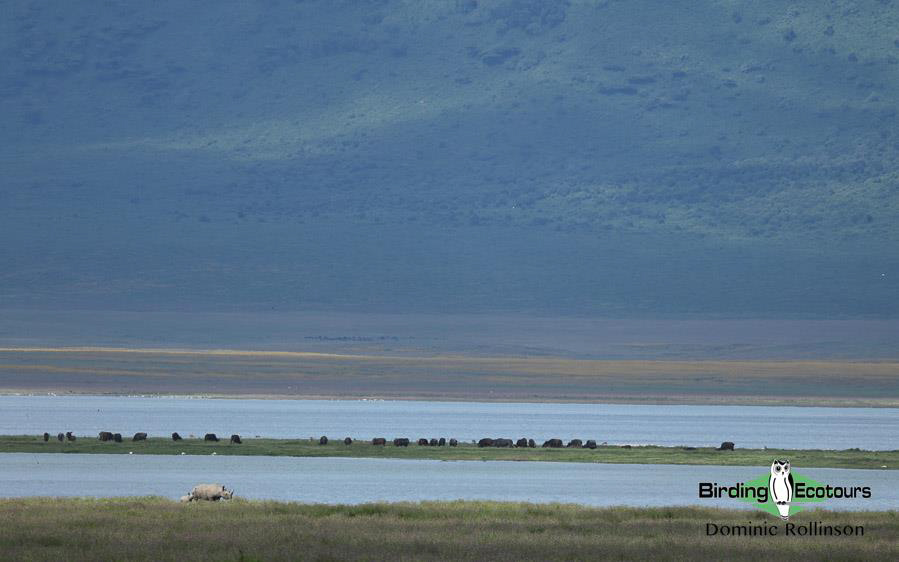
Black Rhino mother and calf with the Ngorongoro Crater as an impressive backdrop.
It was soon time to make our way out of the crater which proved tricky as the birding was just incredible. The sky was also dramatic with dark clouds overhead with the sun breaking through in patches, bathing the area in gorgeous late afternoon light. We birded some smaller pans which were just full of waterbirds, including Fulvous Whistling Duck, Red-billed and Blue-billed Teals, Yellow-billed Duck, Southern Pochard, Whiskered Tern, African Darter, Squacco Heron, Great and Yellow-billed Egrets, Glossy Ibis and an assortment of other common heron species.
As we made our way back out of the crater, we birded some tall woodland, adding White-headed Barbet, while the forested slopes added Cape Robin-Chat, Abyssinian Thrush, White-tailed Blue Flycatcher and a flyby Eastern Bronze-naped Pigeon, before we eventually made our way back to our lovely accommodation in Karatu. This ended a fabulous day which included amazing scenery, masses of animals and an incredible diversity of birds (178 species recorded for the day)!
Day 5, 4th May 2024. Lake Manyara birding and game viewing
Another exciting day dawned as we headed out to Lake Manyara National Park, where we were to spend most of the day. As we entered the park, we soon saw Silvery-cheeked Hornbill, Tambourine Dove, Red-chested Cuckoo, African Goshawk, African Harrier-Hawk, Blue Monkey and a Crowned Eagle on its nest.
We then spent an enjoyable few hours (with a nice lunch stop in between) traversing the tall woodlands on the edge of Lake Manyara. The highlights were many, with standout species including African Hawk-Eagle, Verreaux’s Eagle-Owl, Pearl-spotted Owlet, White-browed Coucal, Green Wood Hoopoe, Crowned and Von Der Decken’s Hornbills, Grey-headed Kingfisher, Bearded Woodpecker, Grey Cuckooshrike, Slate-colored Boubou, White-bellied Tit, Rufous Chatterer, Spotted Palm Thrush, Rufous-tailed Weaver, Black Bishop, Village Indigobird and Mountain Wagtail.
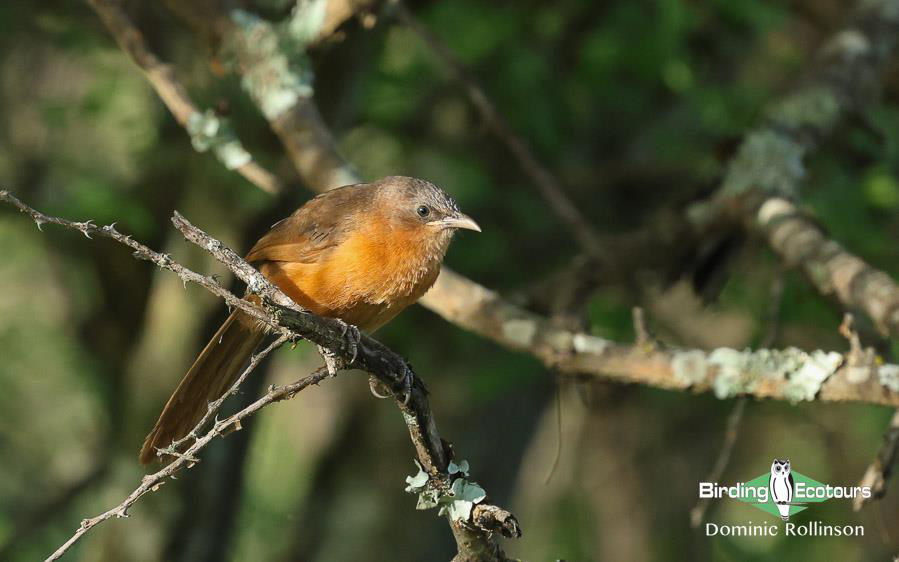
A small group of Rufous Chatterers were seen well at Lake Manyara National Park.
After a thoroughly enjoyable day out, we headed back to our accommodation at Karatu, where we took it easy for most of the remainder of the afternoon. A casual stroll around the lodge grounds and surrounding areas produced the likes of Hildebrandt’s Spurfowl, Fischer’s Lovebird, Silvery-cheeked Hornbill, Tropical Boubou, Black Saw-wing, White-browed Robin-Chat, Holub’s Golden Weaver and Red-billed Firefinch.
Day 6, 5th May 2024. Endoro birding and transfer to Tarangire National Park
This morning we decided to spend some time out of our safari vehicle and enjoyed the Elephant Caves Trail of the Endoro section of Ngorongoro Conservation Area. Our local guide, Emmanuel, was waiting for us on arrival and over the course of the morning, we found an impressive array of forest birds, many of which were new for our already large list. Highlights of the morning included Lemon Dove, Schalow’s Turaco, Ayres’s Hawk-Eagle, Black Sparrowhawk, Narina Trogon, Cinnamon-chested Bee-eater, Moustached Tinkerbird, Pallid and Scaly-throated Honeyguides, African Broadbill, Grey and Purple-throated Cuckooshrikes, Black-fronted Bushshrike, Blue-mantled Crested Flycatcher, Brown-headed Apalis, Grey-capped Warbler, Mountain Greenbul, Brown Woodland Warbler, African Hill Babbler, Mbulu White-eye, Eastern Double-collared Sunbird, Grey-headed Nigrita and Red-throated Twinspot.
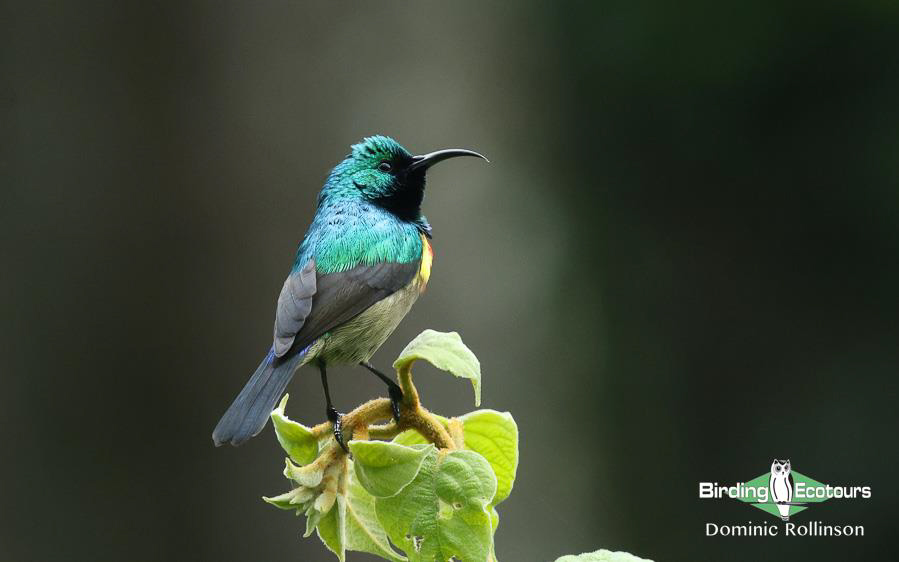
Eastern Double-collared Sunbirds were common along the Elephant Caves Trail.
We then moved around the corner to the beautiful gardens of Gibb’s Farm, where we enjoyed lunch on the balcony while watching the likes of Cinnamon-chested Bee-eater, White-tailed Blue Flycatcher, Green-headed and Bronzy Sunbirds and Black-and-white Mannikins.
After a peaceful (yet bird-filled) lunch, we moved on to Tarangire National Park, where we were based for our final two nights of the trip. On arrival at the Tarangire entrance gate, it did not take long before we had added another two Tanzanian endemics; Ashy Starling and Yellow-collared Lovebird. The drive to camp should not have taken too long but there were just so many birds and animals to be seen that we could not ignore. On the drive to the camp, we encountered Crested Francolin, Yellow-necked and Red-necked Spurfowls, Mourning Collared Dove, Black-faced Sandgrouse, White-bellied Bustard, Northern Red-billed Hornbill, Levaillant’s Cuckoo, Woodland Kingfisher, Lilac-breasted Roller, Red-bellied Parrot, Beautiful Sunbird and so many others. We arrived at our lovely, tented camp overlooking the Tarangire River, where we went to sleep with the sounds of African Scops Owls quietly purring in the distance.
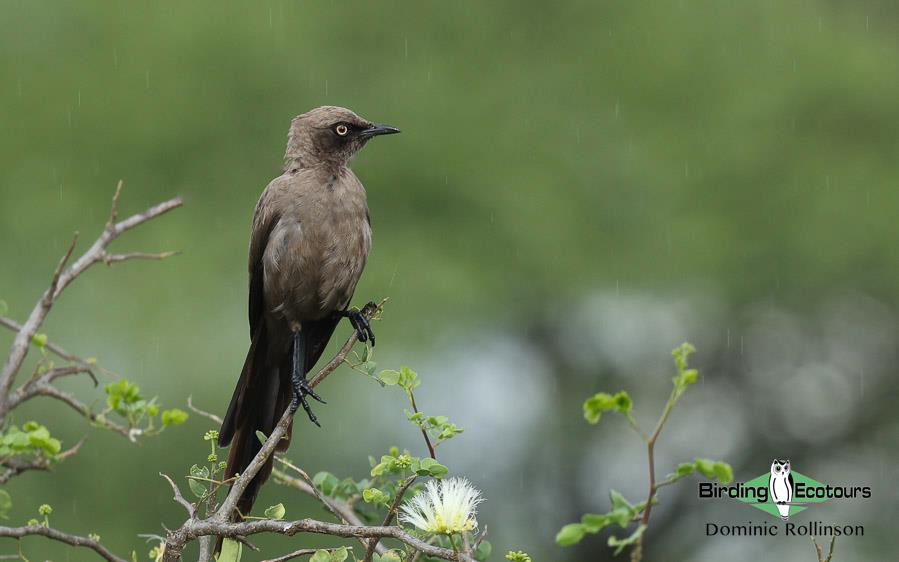
Ashy Starlings welcomed us to Tarangire National Park.
Day 7, 6th May 2024. Tarangire National Park birding and wildlife viewing
We had the exciting prospect of the full day in Tarangire and started off our day with a post-breakfast drive in our safari vehicle. Before we jumped in the vehicle, we enjoyed good looks at a couple of roosting African Scops Owls which showed incredibly well for us. As was to be expected, the drive was full of birds and other exciting wildlife, even though some areas were off-limits today after the previous night’s torrential downpour. Highlights of the drive included Knob-billed Duck, Hildebrandt’s, Yellow-necked and Red-necked Spurfowls, Jacobin Cuckoo, Saddle-billed Stork, Verreax’s Eagle-Owl, Pearl-spotted Owlet, Grey-headed Kingfisher, Greater Honeyguide, Yellow-collared Lovebird, Northern Pied Babbler, Yellow-billed Oxpecker, Ashy Starling, Long-tailed Paradise Whydah, Purple Grenadier, Green-winged Pytilia and Pangani Longclaw.
It’s always fun seeing large mammals such as African Elephant, Lion, African Buffalo as well as some smaller species such as Yellow-spotted Hyrax, all with a magnificent backdrop of huge baobab trees.
After lunch back at our camp, we had some time off in the early afternoon and managed to eke out a few nice birds with a leisurely stroll or two around camp. Some of the birds seen here included Yellow-collared Lovebird (they’re abundant in Tarangire), Red-chested Cuckoo, African Hoopoe, Woodland Kingfisher, Nubian Woodpecker, Black Cuckooshrike, Black-headed Oriole, Buff-bellied Warbler and Eastern Violet-backed Sunbird.
Later that afternoon, once it had cooled down a little, we headed out for another drive which again proved to be highly successful as we found a bunch of exciting species such as Namaqua Dove, White-bellied Bustard, Bare-faced and White-bellied Go-away-birds, Mottled Spinetail, Dwarf Bittern (this was a species Chris was particularly hoping to see), Gabar Goshawk, Von Der Decken’s Hornbill, Red-headed Weaver, Straw-tailed Whydah and another Pangani Longclaw. We finished the afternoon back at camp, enjoying a drink overlooking the Tarangire River while being mobbed by cheeky Ashy Starlings, who were after our popcorn!
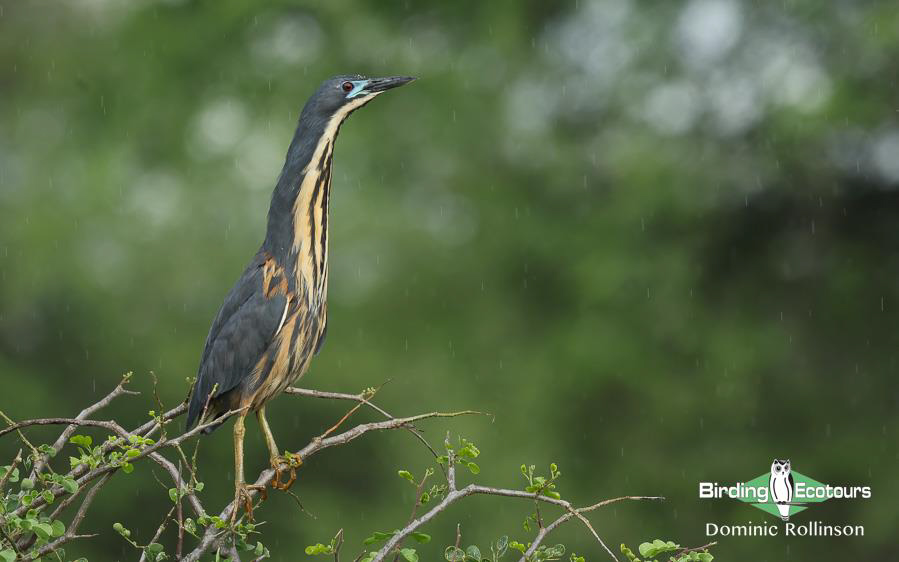
This Dwarf Bittern posed for us in Tarangire National Park.
The action wasn’t yet over for the day though, as after our dinner we had booked onto a night drive, which turned out to be a lot of fun. We had multiple sightings of Verreaux’s Eagle-Owls, Bronze-winged and Three-banded Coursers, Spotted Thick-knee and a single Southern White-faced Owl. On the mammal front, we saw Northern Lesser Galago, African Savanna Hare, East African Springhare and Central African Large-spotted Genet. One of the better night drives I’ve ever been on!
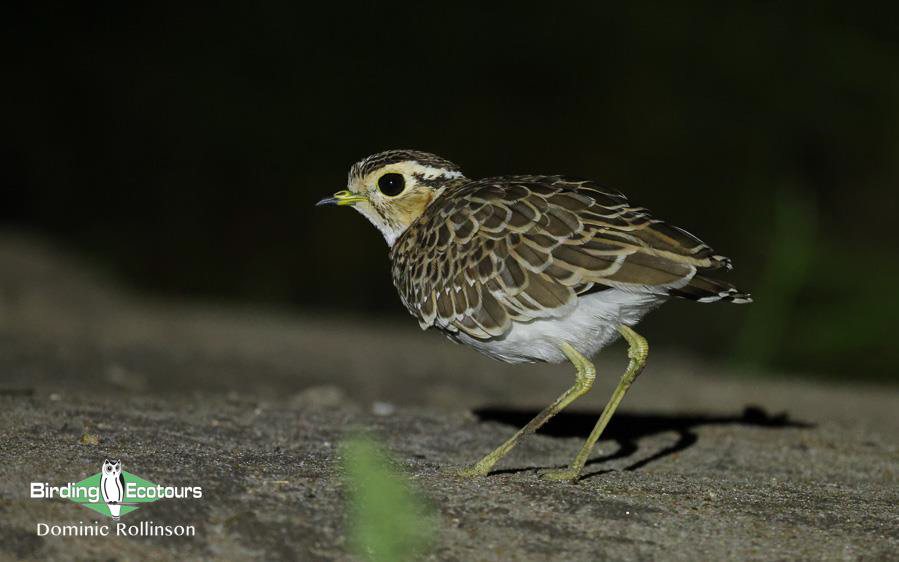
Several Three-banded Coursers were seen on our Tarangire night drive.
Day 8, 7th May 2024. Tarangire National Park and departure
This was the final day of the tour and after breakfast, we again enjoyed another drive around the park. The drive yielded much of the same species as before with some of the notable species including African Harrier-Hawk, Brown Snake Eagle, African Hawk-Eagle, African (Mountain) Grey Woodpecker and Pin-tailed Whydah. We also came across a sizable pride of Lion and had more enjoyable encounters with herds of African Elephants.
The drive back to Arusha was relatively uneventful, with Black-chested Snake Eagle and House Crow added to the list, which left us with 354 bird species seen, along with 38 mammal species. Thanks to Godbless (our driver-guide) for an excellent job navigating some very muddy and tricky roads and to Pam and Chris for making this a thoroughly enjoyable week in Tanzania!
Bird List – Following IOC (December 2023)
Birds ‘heard only’ are marked with (H) after the common name, birds seen by the guide only are marked with a (L) after the common name, all other species were seen both by clients and guide.
The following notation after species names is used to show conservation status following IUCN. CR = Critically Endangered, EN = Endangered, VU = Vulnerable.
| Common name | Scientific name |
| Ostriches (Struthionidae) | |
| Common Ostrich | Struthio camelus |
| Ducks, Geese, Swans (Anatidae) | |
| White-faced Whistling Duck | Dendrocygna viduata |
| Fulvous Whistling Duck | Dendrocygna bicolor |
| Spur-winged Goose | Plectropterus gambensis |
| Egyptian Goose | Alopochen aegyptiaca |
| Blue-billed Teal | Spatula hottentota |
| Yellow-billed Duck | Anas undulata |
| Cape Teal | Anas capensis |
| Red-billed Teal | Anas erythrorhyncha |
| Southern Pochard | Netta erythrophthalma |
| Guineafowl (Numididae) | |
| Helmeted Guineafowl | Numida meleagris |
| Pheasants & Allies (Phasianidae) | |
| Crested Francolin | Ortygornis sephaena |
| Coqui Francolin | Campocolinus coqui |
| Harlequin Quail | Coturnix delegorguei |
| Hildebrandt’s Spurfowl | Pternistis hildebrandti |
| Yellow-necked Spurfowl | Pternistis leucoscepus |
| Grey-breasted Spurfowl | Pternistis rufopictus |
| Red-necked Spurfowl | Pternistis afer |
| Nightjars (Caprimulgidae) | |
| Freckled Nightjar | Caprimulgus tristigma |
| Swifts (Apodidae) | |
| Mottled Spinetail | Telacanthura ussheri |
| African Palm Swift | Cypsiurus parvus |
| Nyanza Swift | Apus niansae |
| Little Swift | Apus affinis |
| White-rumped Swift | Apus caffer |
| Turacos (Musophagidae) | |
| Bare-faced Go-away-bird | Crinifer personatus |
| White-bellied Go-away-bird | Crinifer leucogaster |
| Eastern Plantain-eater | Crinifer zonurus |
| Schalow’s Turaco | Tauraco schalowi |
| Bustards (Otididae) | |
| Kori Bustard | Ardeotis kori |
| White-bellied Bustard | Eupodotis senegalensis |
| Black-bellied Bustard | Lissotis melanogaster |
| Cuckoos (Cuculidae) | |
| White-browed Coucal | Centropus superciliosus |
| Black Coucal | Centropus grillii |
| Great Spotted Cuckoo | Clamator glandarius |
| Levaillant’s Cuckoo | Clamator levaillantii |
| Diederik Cuckoo | Chrysococcyx caprius |
| African Emerald Cuckoo | Chrysococcyx cupreus |
| Black Cuckoo | Cuculus clamosus |
| Red-chested Cuckoo | Cuculus solitarius |
| Sandgrouse (Pteroclidae) | |
| Chestnut-bellied Sandgrouse | Pterocles exustus |
| Black-faced Sandgrouse | Pterocles decoratus |
| Pigeons, Doves (Columbidae) | |
| Rock Dove | Columba livia |
| Speckled Pigeon | Columba guinea |
| African Olive Pigeon | Columba arquatrix |
| Eastern Bronze-naped Pigeon | Columba delegorguei |
| Lemon Dove | Columba larvata |
| Mourning Collared Dove | Streptopelia decipiens |
| Red-eyed Dove | Streptopelia semitorquata |
| Ring-necked Dove | Streptopelia capicola |
| Laughing Dove | Spilopelia senegalensis |
| Emerald-spotted Wood Dove | Turtur chalcospilos |
| Namaqua Dove | Oena capensis |
| African Green Pigeon | Treron calvus |
| Rails, Crakes & Coots (Rallidae) | |
| Common Moorhen | Gallinula chloropus |
| Red-knobbed Coot | Fulica cristata |
| Black Crake | Zapornia flavirostra |
| Cranes (Gruidae) | |
| Grey Crowned Crane – EN | Balearica regulorum |
| Grebes (Podicipedidae) | |
| Little Grebe | Tachybaptus ruficollis |
| Black-necked Grebe | Podiceps nigricollis |
| Flamingos (Phoenicopteridae) | |
| Greater Flamingo | Phoenicopterus roseus |
| Lesser Flamingo | Phoeniconaias minor |
| Stone-curlews, Thick-knees (Burhinidae) | |
| Spotted Thick-knee | Burhinus capensis |
| Stilts, Avocets (Recurvirostridae) | |
| Black-winged Stilt | Himantopus himantopus |
| Pied Avocet | Recurvirostra avosetta |
| Plovers (Charadriidae) | |
| Three-banded Plover | Charadrius tricollaris |
| Long-toed Lapwing | Vanellus crassirostris |
| Blacksmith Lapwing | Vanellus armatus |
| Spur-winged Lapwing | Vanellus spinosus |
| Crowned Lapwing | Vanellus coronatus |
| Kittlitz’s Plover | Anarhynchus pecuarius |
| Painted-snipes (Rostratulidae) | |
| Greater Painted-snipe | Rostratula benghalensis |
| Sandpipers, Snipes (Scolopacidae) | |
| Wood Sandpiper | Tringa glareola |
| Common Greenshank | Tringa nebularia |
| Curlew Sandpiper | Calidris ferruginea |
| Coursers, Pratincoles (Glareolidae) | |
| Double-banded Courser | Rhinoptilus africanus |
| Bronze-winged Courser | Rhinoptilus chalcopterus |
| Three-banded Courser | Rhinoptilus cinctus |
| Temminck’s Courser | Cursorius temminckii |
| Gulls, Terns, Skimmers (Laridae) | |
| Gull-billed Tern | Gelochelidon nilotica |
| Whiskered Tern | Chlidonias hybrida |
| Grey-headed Gull | Chroicocephalus cirrocephalus |
| Storks (Ciconiidae) | |
| African Openbill | Anastomus lamelligerus |
| Marabou Stork | Leptoptilos crumenifer |
| Yellow-billed Stork | Mycteria ibis |
| White Stork | Ciconia ciconia |
| Cormorants, Shags (Phalacrocoracidae) | |
| Reed Cormorant | Microcarbo africanus |
| Ibises, Spoonbills (Threskiornithidae) | |
| African Sacred Ibis | Threskiornis aethiopicus |
| Hadada Ibis | Bostrychia hagedash |
| Glossy Ibis | Plegadis falcinellus |
| African Spoonbill | Platalea alba |
| Herons, Bitterns (Ardeidae) | |
| Little Egret | Egretta garzetta |
| Striated Heron | Butorides striata |
| Squacco Heron | Ardeola ralloides |
| Western Cattle Egret | Bubulcus ibis |
| Great Egret | Ardea alba |
| Yellow-billed Egret | Ardea brachyrhyncha |
| Grey Heron | Ardea cinerea |
| Black-headed Heron | Ardea melanocephala |
| Hamerkop (Scopidae) | |
| Hamerkop | Scopus umbretta |
| Pelicans (Pelecanidae) | |
| Great White Pelican | Pelecanus onocrotalus |
| Pink-backed Pelican | Pelecanus rufescens |
| Secretarybird (Sagittariidae) | |
| Secretarybird – EN | Sagittarius serpentarius |
| Kites, Hawks, Eagles (Accipitridae) | |
| Black-winged Kite | Elanus caeruleus |
| African Harrier-Hawk | Polyboroides typus |
| Hooded Vulture – CR | Necrosyrtes monachus |
| White-backed Vulture – CR | Gyps africanus |
| White-headed Vulture – CR | Trigonoceps occipitalis |
| Lappet-faced Vulture – EN | Torgos tracheliotos |
| Brown Snake Eagle | Circaetus cinereus |
| Bateleur – EN | Terathopius ecaudatus |
| Crowned Eagle | Stephanoaetus coronatus |
| Long-crested Eagle | Lophaetus occipitalis |
| Wahlberg’s Eagle | Hieraaetus wahlbergi |
| Ayres’s Hawk-Eagle | Hieraaetus ayresii |
| Tawny Eagle – VU | Aquila rapax |
| African Hawk-Eagle | Aquila spilogaster |
| Lizard Buzzard | Kaupifalco monogrammicus |
| Gabar Goshawk | Micronisus gabar |
| Dark Chanting Goshawk | Melierax metabates |
| Eastern Chanting Goshawk | Melierax poliopterus |
| African Goshawk | Accipiter tachiro |
| Black Sparrowhawk | Accipiter melanoleucus |
| Yellow-billed Kite | Milvus aegyptius |
| African Fish Eagle | Icthyophaga vocifer |
| Mountain Buzzard | Buteo oreophilus |
| Augur Buzzard | Buteo augur |
| Owls (Strigidae) | |
| Pearl-spotted Owlet | Glaucidium perlatum |
| African Scops Owl | Otus senegalensis |
| Verreaux’s Eagle-Owl | Ketupa lactea |
| Mousebirds (Coliidae) | |
| Speckled Mousebird | Colius striatus |
| White-headed Mousebird | Colius leucocephalus |
| Blue-naped Mousebird | Urocolius macrourus |
| Trogons (Trogonidae) | |
| Narina Trogon | Apaloderma narina |
| Hoopoes (Upupidae) | |
| African Hoopoe | Upupa africana |
| Wood Hoopoes (Phoeniculidae) | |
| Green Wood Hoopoe | Phoeniculus purpureus |
| Common Scimitarbill | Rhinopomastus cyanomelas |
| Abyssinian Scimitarbill | Rhinopomastus minor |
| Hornbills (Bucerotidae) | |
| Tanzanian Red-billed Hornbill | Tockus ruahae |
| Northern Red-billed Hornbill | Tockus erythrorhynchus |
| Von der Decken’s Hornbill | Tockus deckeni |
| Crowned Hornbill | Lophoceros alboterminatus |
| African Grey Hornbill | Lophoceros nasutus |
| Silvery-cheeked Hornbill | Bycanistes brevis |
| Rollers (Coraciidae) | |
| Lilac-breasted Roller | Coracias caudatus |
| European Roller | Coracias garrulus |
| Kingfishers (Alcedinidae) | |
| Grey-headed Kingfisher | Halcyon leucocephala |
| Brown-hooded Kingfisher | Halcyon albiventris |
| Striped Kingfisher | Halcyon chelicuti |
| Woodland Kingfisher | Halcyon senegalensis |
| Malachite Kingfisher | Corythornis cristatus |
| Giant Kingfisher | Megaceryle maxima |
| Pied Kingfisher | Ceryle rudis |
| Bee-eaters (Meropidae) | |
| Little Bee-eater | Merops pusillus |
| Cinnamon-chested Bee-eater | Merops oreobates |
| White-fronted Bee-eater | Merops bullockoides |
| Olive Bee-eater | Merops superciliosus |
| African Barbets (Lybiidae) | |
| Red-and-yellow Barbet | Trachyphonus erythrocephalus |
| D’Arnaud’s Barbet | Trachyphonus darnaudii |
| Usambiro Barbet | Trachyphonus usambiro |
| White-eared Barbet | Stactolaema leucotis |
| Red-fronted Tinkerbird | Pogoniulus pusillus |
| Red-fronted Barbet | Tricholaema diademata |
| White-headed Barbet | Lybius leucocephalus |
| Honeyguides (Indicatoridae | |
| Green-backed Honeybird | Prodotiscus zambesiae |
| Pallid Honeyguide | Indicator meliphilus |
| Scaly-throated Honeyguide | Indicator variegatus |
| Woodpeckers (Picidae) | |
| Nubian Woodpecker | Campethera nubica |
| Bearded Woodpecker | Chloropicus namaquus |
| Cardinal Woodpecker | Dendropicos fuscescens |
| African Grey Woodpecker | Dendropicos goertae |
| Eastern Grey Woodpecker | Dendropicos spodocephalus |
| Caracaras, Falcons (Falconidae) | |
| Pygmy Falcon | Polihierax semitorquatus |
| Common Kestrel | Falco tinnunculus |
| Greater Kestrel | Falco rupicoloides |
| Grey Kestrel | Falco ardosiaceus |
| Lanner Falcon | Falco biarmicus |
| African & New World Parrots (Psittacidae) | |
| Meyer’s Parrot | Poicephalus meyeri |
| Red-bellied Parrot | Poicephalus rufiventris |
| Old World Parrots (Psittaculidae) | |
| Fischer’s Lovebird | Agapornis fischeri |
| Yellow-collared Lovebird | Agapornis personatus |
| Wattle-eyes, Batises (Platysteiridae) | |
| Chinspot Batis | Batis molitor |
| Pygmy Batis | Batis perkeo |
| Black-throated Wattle-eye | Platysteira peltata |
| Bushshrikes (Malaconotidae) | |
| Grey-headed Bushshrike | Malaconotus blanchoti |
| Black-fronted Bushshrike | Chlorophoneus nigrifrons |
| Orange-breasted Bushshrike | Chlorophoneus sulfureopectus |
| Rosy-patched Bushshrike | Telophorus cruentus |
| Brown-crowned Tchagra | Tchagra australis |
| Black-crowned Tchagra | Tchagra senegalus |
| Black-backed Puffback | Dryoscopus cubla |
| Slate-colored Boubou | Laniarius funebris |
| Tropical Boubou | Laniarius major |
| Black-headed Gonolek | Laniarius erythrogaster |
| Brubru | Nilaus afer |
| Vangas & Allies (Vangidae) | |
| White-crested Helmetshrike | Prionops plumatus |
| Cuckooshrikes (Campephagidae) | |
| Grey Cuckooshrike | Ceblepyris caesius |
| Purple-throated Cuckooshrike | Campephaga quiscalina |
| Figbirds, Old World Orioles, Piopios (Oriolidae) | |
| Black-headed Oriole | Oriolus larvatus |
| Drongos (Dicruridae) | |
| Fork-tailed Drongo | Dicrurus adsimilis |
| Monarchs (Monarchidae) | |
| Blue-mantled Crested Flycatcher | Trochocercus cyanomelas |
| African Paradise Flycatcher | Terpsiphone viridis |
| Shrikes (Laniidae) | |
| Northern White-crowned Shrike | Eurocephalus ruppelli |
| Magpie Shrike | Lanius melanoleucus |
| Long-tailed Fiscal | Lanius cabanisi |
| Grey-backed Fiscal | Lanius excubitoroides |
| Taita Fiscal | Lanius dorsalis |
| Northern Fiscal | Lanius humeralis |
| Crows, Jays (Corvidae) | |
| Pied Crow | Corvus albus |
| White-necked Raven | Corvus albicollis |
| Fairy Flycatchers (Stenostiridae) | |
| White-tailed Blue Flycatcher | Elminia albicauda |
| Tits, Chickadees (Paridae) | |
| White-bellied Tit | Melaniparus albiventris |
| Red-throated Tit | Melaniparus fringillinus |
| Penduline Tits (Remizidae) | |
| Grey Penduline Tit | Anthoscopus caroli |
| Larks (Alaudidae) | |
| Beesley’s Lark – CR | Chersomanes beesleyi |
| Fischer’s Sparrow-Lark | Eremopterix leucopareia |
| Foxy Lark | Calendulauda alopex |
| Rufous-naped Lark | Mirafra africana |
| Flappet Lark | Mirafra rufocinnamomea |
| Short-tailed Lark | Spizocorys fremantlii |
| Red-capped Lark | Calandrella cinerea |
| Athi Short-toed Lark | Alaudala athensis |
| Bulbuls (Pycnonotidae) | |
| Yellow-bellied Greenbul | Chlorocichla flaviventris |
| Mountain Greenbul | Arizelocichla nigriceps |
| Little Greenbul | Eurillas virens |
| Grey-olive Greenbul | Phyllastrephus cerviniventris |
| Dark-capped Bulbul | Pycnonotus tricolor |
| Swallows, Martins (Hirundinidae) | |
| Black Saw-wing | Psalidoprocne pristoptera |
| Banded Martin | Neophedina cincta |
| Brown-throated Martin | Riparia paludicola |
| Rock Martin | Ptyonoprogne fuligula |
| Barn Swallow | Hirundo rustica |
| Wire-tailed Swallow | Hirundo smithii |
| Red-rumped Swallow | Cecropis daurica |
| Lesser Striped Swallow | Cecropis abyssinica |
| Crombecs, African Warblers (Macrosphenidae) | |
| Northern Crombec | Sylvietta brachyura |
| Red-faced Crombec | Sylvietta whytii |
| Leaf Warblers (Phylloscopidae) | |
| Brown Woodland Warbler | Phylloscopus umbrovirens |
| Cisticolas & Allies (Cisticolidae) | |
| Red-faced Cisticola | Cisticola erythrops |
| Singing Cisticola | Cisticola cantans |
| Hunter’s Cisticola | Cisticola hunteri |
| Rattling Cisticola | Cisticola chiniana |
| Ashy Cisticola | Cisticola cinereolus |
| Lynes’s Cisticola | Cisticola distinctus |
| Winding Cisticola | Cisticola marginatus |
| Croaking Cisticola | Cisticola natalensis |
| Zitting Cisticola | Cisticola juncidis |
| Desert Cisticola | Cisticola aridulus |
| Pectoral-patch Cisticola | Cisticola brunnescens |
| Tawny-flanked Prinia | Prinia subflava |
| Red-fronted Prinia | Prinia rufifrons |
| Buff-bellied Warbler | Phyllolais pulchella |
| Bar-throated Apalis | Apalis thoracica |
| Yellow-breasted Apalis | Apalis flavida |
| Karamoja Apalis – VU | Apalis karamojae |
| Brown-headed Apalis | Apalis alticola |
| Grey-capped Warbler | Eminia lepida |
| Grey-backed Camaroptera | Camaroptera brevicaudata |
| Grey Wren-Warbler | Calamonastes simplex |
| Yellow-bellied Eremomela | Eremomela icteropygialis |
| Sylviid Babblers (Sylviidae) | |
| African Hill Babbler | Sylvia abyssinica |
| Banded Parisoma | Curruca boehmi |
| White-eyes (Zosteropidae) | |
| Pale White-eye | Zosterops flavilateralis |
| Mbulu White-eye | Zosterops mbuluensis |
| Laughingthrushes & Allies (Leiothrichidae) | |
| Rufous Chatterer | Argya rubiginosa |
| Arrow-marked Babbler | Turdoides jardineii |
| Black-lored Babbler | Turdoides sharpei |
| Starlings, Rhabdornises (Sturnidae) | |
| Wattled Starling | Creatophora cinerea |
| Rüppell’s Starling | Lamprotornis purpuroptera |
| Superb Starling | Lamprotornis superbus |
| Hildebrandt’s Starling | Lamprotornis hildebrandti |
| Ashy Starling | Lamprotornis unicolor |
| Red-winged Starling | Onychognathus morio |
| Sharpe’s Starling | Pholia sharpii |
| Oxpeckers (Buphagidae) | |
| Yellow-billed Oxpecker | Buphagus africanus |
| Red-billed Oxpecker | Buphagus erythrorynchus |
| Thrushes (Turdidae) | |
| Abyssinian Thrush | Turdus abyssinicus |
| Bare-eyed Thrush | Turdus tephronotus |
| Chats, Old World Flycatchers (Muscicapidae) | |
| White-browed Scrub Robin | Cercotrichas leucophrys |
| Ashy Flycatcher | Fraseria caerulescens |
| White-eyed Slaty Flycatcher | Melaenornis fischeri |
| Silverbird | Empidornis semipartitus |
| African Grey Flycatcher | Bradornis microrhynchus |
| African Dusky Flycatcher | Muscicapa adusta |
| White-browed Robin-Chat | Cossypha heuglini |
| Rüppell’s Robin-Chat | Cossypha semirufa |
| Red-capped Robin-Chat | Cossypha natalensis |
| Spotted Palm Thrush | Cichladusa guttata |
| Cape Robin-Chat | Dessonornis caffer |
| African Stonechat | Saxicola torquatus |
| Anteater Chat | Myrmecocichla aethiops |
| Capped Wheatear | Oenanthe pileata |
| Abyssinian Wheatear | Oenanthe lugubris |
| Sunbirds (Nectariniidae) | |
| Eastern Violet-backed Sunbird | Anthreptes orientalis |
| Collared Sunbird | Hedydipna collaris |
| Green-headed Sunbird | Cyanomitra verticalis |
| Olive Sunbird | Cyanomitra olivacea |
| Amethyst Sunbird | Chalcomitra amethystina |
| Scarlet-chested Sunbird | Chalcomitra senegalensis |
| Bronzy Sunbird | Nectarinia kilimensis |
| Golden-winged Sunbird | Drepanorhynchus reichenowi |
| Eastern Double-collared Sunbird | Cinnyris mediocris |
| Beautiful Sunbird | Cinnyris pulchellus |
| Variable Sunbird | Cinnyris venustus |
| Old World Sparrows, Snowfinches (Passeridae) | |
| Yellow-spotted Bush Sparrow | Gymnoris pyrgita |
| Chestnut Sparrow | Passer eminibey |
| Kenya Sparrow | Passer rufocinctus |
| Northern Grey-headed Sparrow | Passer griseus |
| Swahili Sparrow | Passer suahelicus |
| House Sparrow | Passer domesticus |
| Weavers, Widowbirds (Ploceidae) | |
| Red-billed Buffalo Weaver | Bubalornis niger |
| White-headed Buffalo Weaver | Dinemellia dinemelli |
| White-browed Sparrow-Weaver | Plocepasser mahali |
| Rufous-tailed Weaver | Histurgops ruficauda |
| Grey-capped Social Weaver | Pseudonigrita arnaudi |
| Speckle-fronted Weaver | Sporopipes frontalis |
| Thick-billed Weaver | Amblyospiza albifrons |
| Baglafecht Weaver | Ploceus baglafecht |
| Spectacled Weaver | Ploceus ocularis |
| Black-necked Weaver | Ploceus nigricollis |
| Holub’s Golden Weaver | Ploceus xanthops |
| Taveta Weaver | Ploceus castaneiceps |
| Lesser Masked Weaver | Ploceus intermedius |
| Vitelline Masked Weaver | Ploceus vitellinus |
| Speke’s Weaver | Ploceus spekei |
| Village Weaver | Ploceus cucullatus |
| Red-headed Weaver | Anaplectes rubriceps |
| Red-billed Quelea | Quelea quelea |
| Yellow-crowned Bishop | Euplectes afer |
| Black Bishop | Euplectes gierowii |
| Southern Red Bishop | Euplectes orix |
| Fan-tailed Widowbird | Euplectes axillaris |
| White-winged Widowbird | Euplectes albonotatus |
| Waxbills, Munias & Allies (Estrildidae) | |
| Black-and-white Mannikin | Spermestes bicolor |
| Yellow-bellied Waxbill | Coccopygia quartinia |
| Grey-headed Nigrita | Nigrita canicapillus |
| Black-faced Waxbill | Brunhilda erythronotos |
| Quailfinch | Ortygospiza atricollis |
| Purple Grenadier | Granatina ianthinogaster |
| Red-cheeked Cordon-bleu | Uraeginthus bengalus |
| Blue-capped Cordon-bleu | Uraeginthus cyanocephalus |
| Green-winged Pytilia | Pytilia melba |
| Red-throated Twinspot | Hypargos niveoguttatus |
| Red-billed Firefinch | Lagonosticta senegala |
| African Firefinch | Lagonosticta rubricata |
| Indigobirds, Whydahs (Viduidae) | |
| Village Indigobird | Vidua chalybeata |
| Pin-tailed Whydah | Vidua macroura |
| Steel-blue Whydah | Vidua hypocherina |
| Straw-tailed Whydah | Vidua fischeri |
| Long-tailed Paradise Whydah | Vidua paradisaea |
| Wagtails, Pipits (Motacillidae) | |
| Mountain Wagtail | Motacilla clara |
| African Pied Wagtail | Motacilla aguimp |
| Yellow-throated Longclaw | Macronyx croceus |
| Pangani Longclaw | Macronyx aurantiigula |
| Rosy-throated Longclaw | Macronyx ameliae |
| African Pipit | Anthus cinnamomeus |
| Plain-backed Pipit | Anthus leucophrys |
| Finches, Euphonias (Fringillidae) | |
| Southern Citril | Crithagra hyposticta |
| Reichenow’s Seedeater | Crithagra reichenowi |
| White-bellied Canary | Crithagra dorsostriata |
| Southern Grosbeak-Canary | Crithagra buchanani |
| Thick-billed Seedeater | Crithagra burtoni |
| Streaky Seedeater | Crithagra striolata |
| Buntings (Emberizidae) | |
| Golden-breasted Bunting | Emberiza flaviventris |
| Species Seen | 354 |
| Species heard only | 10 |
| Leader only | 1 |
| Total species recorded | 365 |
Mammal List – Following Mammalwatching.com (April 2024)
The following notation after species names is used to show conservation status following the IUCN Red List: CR = Critically Endangered, EN = Endangered, VU = Vulnerable.
| Common name | Scientific name |
| Hyraxes (Procaviidae) | |
| Yellow-spotted Hyrax | Heterohyrax brucei |
| Elephants (Elephantidae) | |
| African Savanna Elephant – EN | Loxodonta africana |
| Hares and Rabbits (Hystricidae) | |
| African Savanna Hare | Lepus victoriae |
| Springhares (Pedetidae) | |
| East African Springhare | Pedetes surdaster |
| Squirrels (Sciuridae) | |
| Ochre Bush Squirrel | Paraxerus ochraceus |
| Galagos (Galagidae) | |
| Northern Lesser Galago | Galago senegalensis |
| Old World Monkeys (Cercopithecidae) | |
| Blue Monkey | Cercopithecus mitis |
| Vervet Monkey | Chlorocebus pygerythrus |
| Olive Baboon | Papio anubis |
| Felids (Felidae) | |
| Cheetah – VU | Acinonyx jubatus |
| Lion – VU | Panthera leo |
| Civets, Genets and Oyans (Viverridae) | |
| Central African Large-spotted Genet | Genetta maculata |
| Hyaenas (Hyaenidae) | |
| Spotted Hyaena | Hyaena hyaena |
| Mongooses (Herpestidae) | |
| White-tailed Mongoose | Ichneumia albicauda |
| Common Slender Mongoose | Herpestes sanguineus |
| Common Dwarf Mongoose | Helogale parvula |
| Banded Mongoose | Mungos mungo |
| Canids (Canidae) | |
| Black-backed Jackal | Lupulella mesomelas |
| Rhinoceroses (Rhinocerotidae) | |
| Black Rhinoceros – CR | Diceros bicornis |
| Equines (Equidae) | |
| Plains Zebra | Equus quagga |
| Bovids (Bovidae) | |
| Impala | Aepyceros melampus |
| Hartebeest | Alcelaphus buselaphus |
| Blue Wildebeest | Connochaetes taurinus |
| Tsessebe | Damaliscus lunatus |
| Thomson’s Gazelle | Eudorcas thomsonii |
| Kirk’s Dik-dik | Madoqua kirkii |
| Grant’s Gazelle | Nanger granti |
| Common Duiker | Sylvicapra grimmia |
| Klipspringer | Oreotragus oreotragus |
| Bohor Reedbuck | Redunca redunca |
| Waterbuck | Kobus ellipsiprymnus |
| Cape Buffalo | Syncerus caffer |
| Common Eland | Tragelaphus oryx |
| Southern Bushbuck | Tragelaphus sylvaticus |
| Giraffes and Okapi (Giraffidae) | |
| Maasai Giraffe | Giraffa tippelskirchi |
| Suids (Suidae) | |
| Common Warthog | Phacochoerus africanus |
| Bushpig | Potamochoerus larvatus |
| Hippopotamuses (Hippopotamidae) | |
| Common Hippopotamus – VU | Hippopotamus amphibius |
| Species Seen | 38 |
DOWNLOAD TRIP REPORT
Please see the downloadable PDF above with the full species lists included. This is a sample trip report. Please email us ([email protected]) for more trip reports from this destination.
